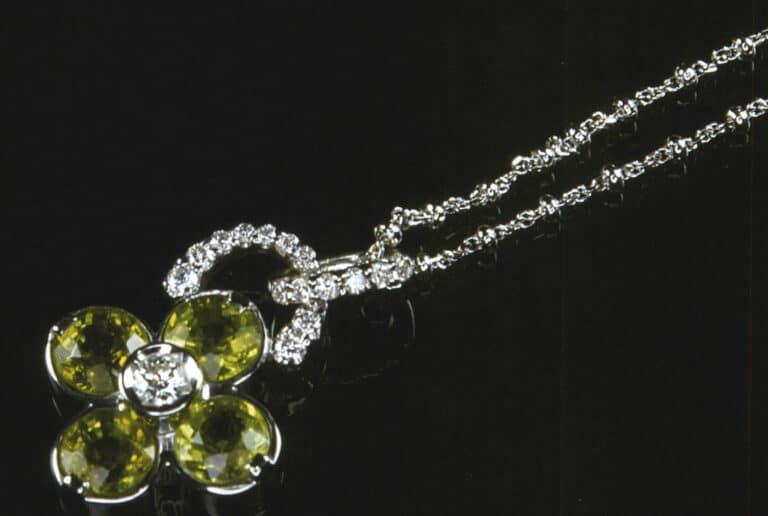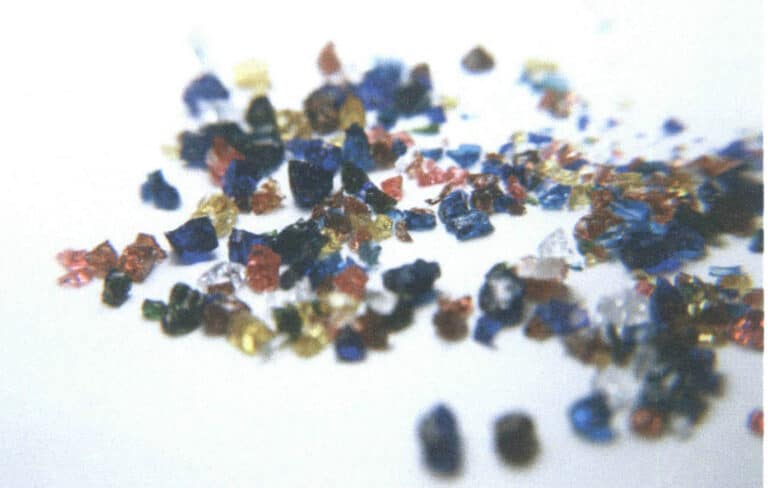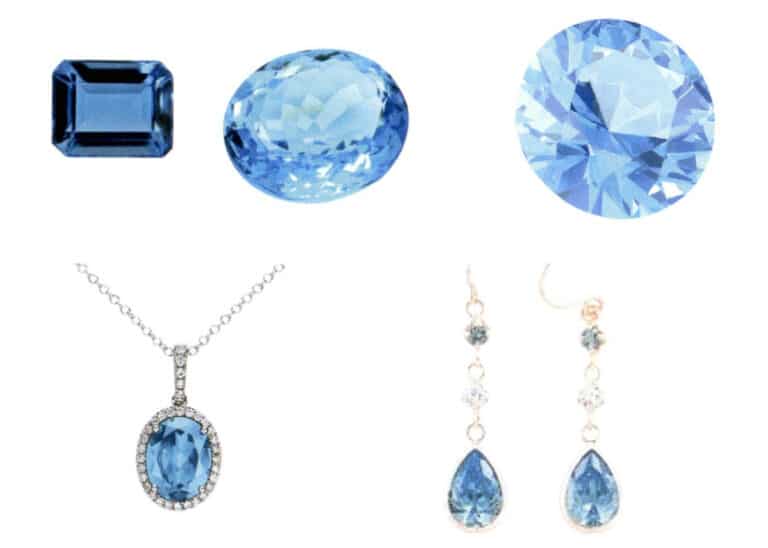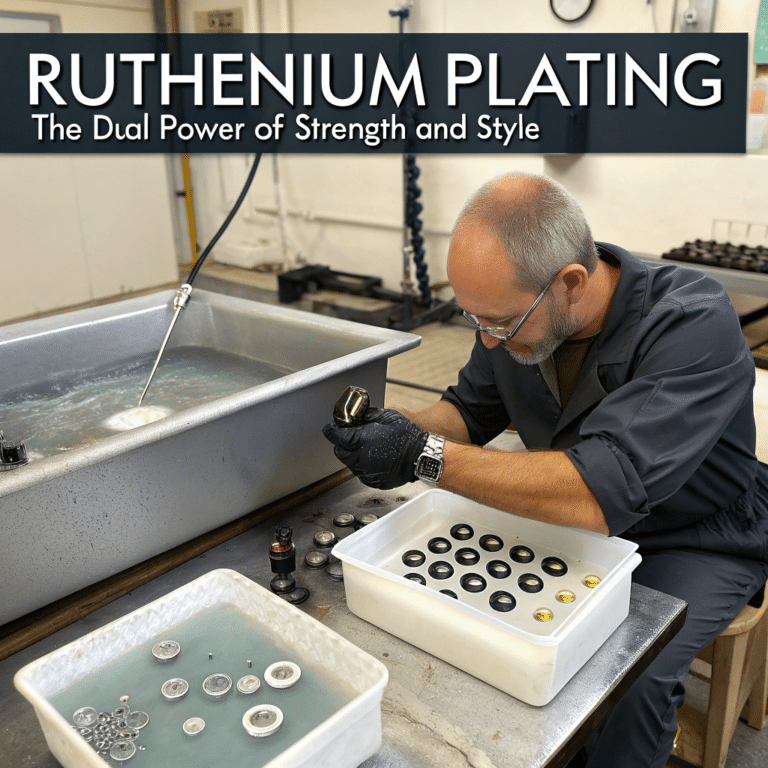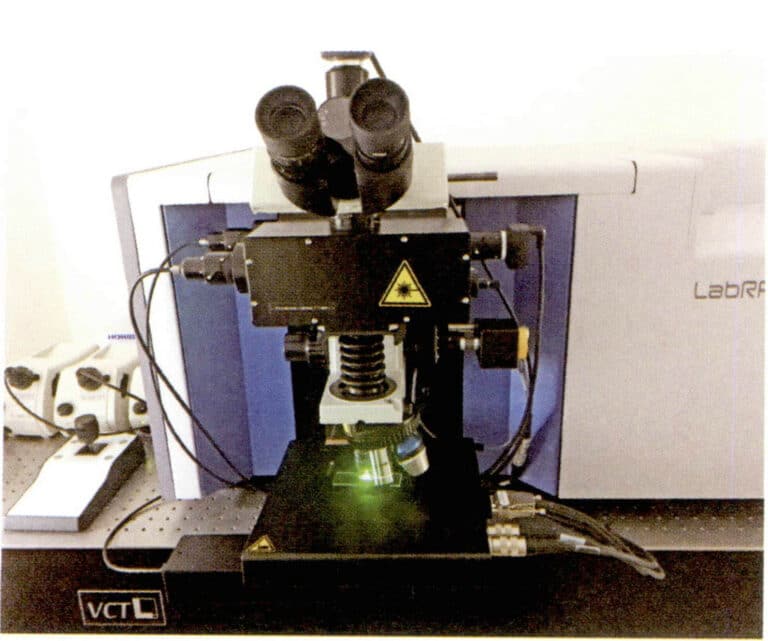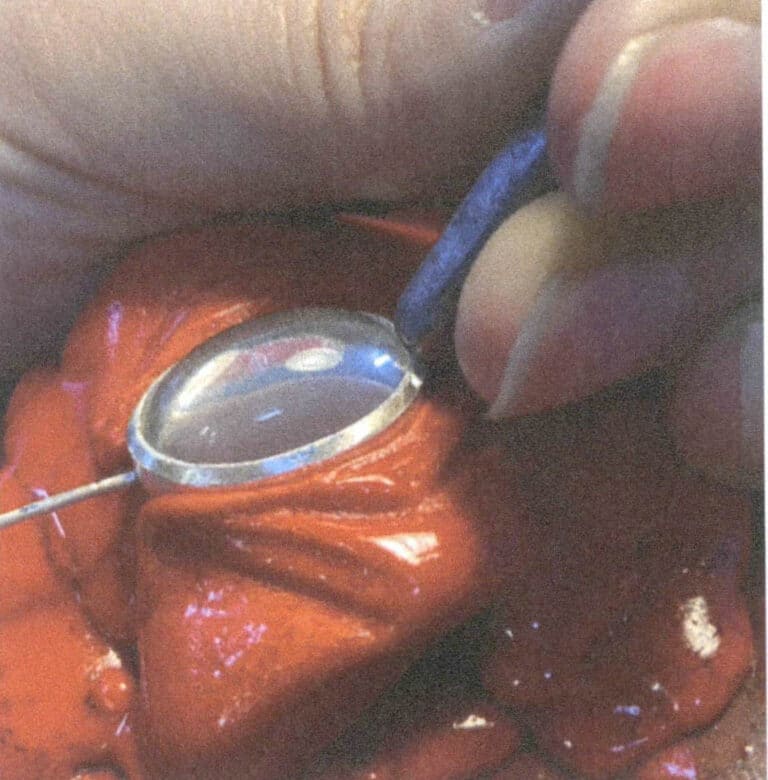Batu Permata yang Bercahaya: Panduan Anda untuk Membeli Perhiasan yang Cemerlang
15 Batu Permata Terpopuler
Pendahuluan:
Selain kelima raja dunia tersebut, ada kategori batu permata yang sangat dicari di pasar, disukai oleh produsen dan desainer merek internasional, dan sering ditampilkan dalam pameran perhiasan dan media cetak yang dikenal sebagai batu permata populer.
Harga batu permata populer tidak terlalu mahal dibandingkan dengan batu permata berharga, yang dapat dibeli mulai dari beberapa dolar hingga ribuan dolar untuk satu karat. Permata ini dapat ditemukan dalam segala hal, mulai dari selebriti modis yang gemar menggunakan label desainer, ibu-ibu yang gemar berbelanja di TV, hingga para spiritualis yang memakainya untuk praktik dan ucapan spiritual mereka. Inilah 15 permata teratas.

Daftar Isi
Bagian ⅠTourmaline
Nama Tourmaline berasal dari kata Sinhala "turmali" di Sri Lanka, yang berarti batu permata dengan warna campuran. banyak bisnis yang membuat Bi Ru menjadi jimat ponsel, yang diklaim dapat mencegah gelombang elektromagnetik; membuatnya menjadi kasur, yang diklaim memiliki efek inframerah-jauh yang dapat meningkatkan kualitas tidur; dan menggunakannya dalam rendaman kaki, yang dikatakan dapat meningkatkan metabolisme dan sirkulasi darah.
| Komposisi | Sistem kristal | Kekerasan | Gravitasi Spesifik | Indeks refraksi | Warna | Pembelahan | Patah tulang |
|---|---|---|---|---|---|---|---|
| (Na, Ca) (Li, Mg, Al) (Al, Fe, Mn)6(BO)3)3Si6O18(OH) | Sistem kristal heksagonal | 7 ~ 7.5 | 3,0 ~ 3,25 (bervariasi menurut elemen) | 1.615 ~ 1.638 | Variasi besar dengan komposisi | / | Seperti cangkang |
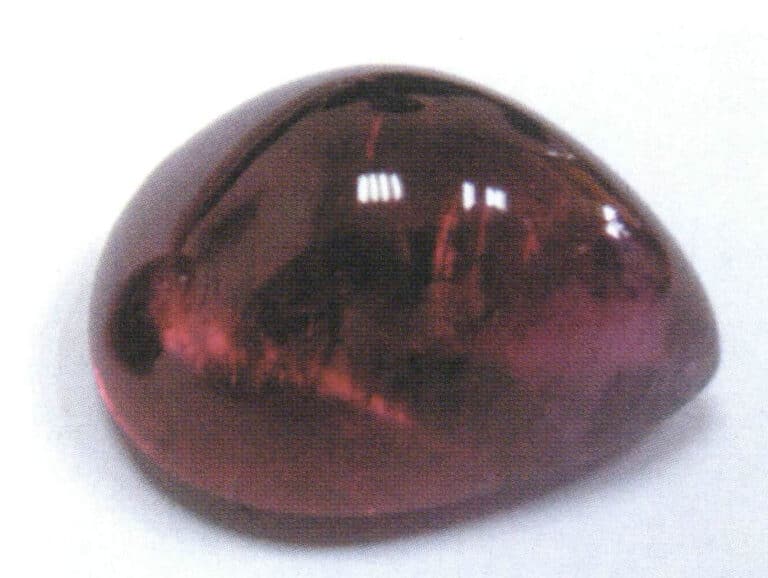
Turmalin telah terkenal selama hampir dua puluh tahun; baik di toko perhiasan, konter merek internasional, atau acara-acara sosial di kalangan sosialita, batu ini selalu menjadi pusat perhatian. Alasan popularitas turmalin adalah warnanya yang cerah, mulai dari merah, kuning, ungu, biru-abu-abu, dan oranye hingga merah muda, dengan seri merah saja memiliki lima atau enam corak yang berbeda. Merek mewah internasional Bulgari, yang berfokus pada warna dalam desainnya, sering menggunakan turmalin sebagai bahan untuk membuat berbagai perhiasan, menyebarkan pengaruhnya di dunia mode.
Alasan kedua untuk popularitas turmalin adalah harganya yang terjangkau. Warna turmalin cerah dan seragam, kedua setelah rubi dan safir, dengan api yang mirip dengan rubi, tetapi harganya jauh lebih rendah daripada rubi dan safir, menjadikannya pilihan terbaik untuk pemula dalam batu permata.
Gelang dan kalung turmalin standar sering kali memiliki banyak pengotor internal, biasanya dihargai per gram, dengan gelang berkualitas mulai dari beberapa ratus hingga lebih dari seribu dolar; liontin dan ukiran turmalin, yang sering kali diolah dengan resin, juga dihargai per gram, dengan harga pasar untuk liontin mulai dari lebih dari US $ 1.050.000. Sedangkan untuk cabochon, turmalin cenderung memiliki sedikit lebih banyak pengotor, biasanya dihargai US$15-109 per karat. Tergantung pada berat turmalin ruby faceted kelas tertinggi, harga per karatnya adalah US$93-312.
Turmalin hadir dalam berbagai warna. Yang paling terkenal adalah Rubellite dan turmalin semangka. Rubellite yang mulia sangat menarik perhatian seperti mawar merah menyala, berkilau dan membakar gairah wanita dewasa; turmalin semangka, dengan warna hijau dan merahnya, bahkan lebih menarik. Namun, beberapa orang jatuh cinta pada pandangan pertama dengan turmalin dua warna, karena pembatas warnanya yang berbeda dan unik, membuatnya menjadi favorit di antara para kolektor. Sedangkan untuk warna biru dan Verdelite, masing-masing mewakili penegasan karier pria yang sukses dan kualitas cerdas seorang wanita dewasa.
1. Rubellite
Karena warnanya sangat mirip dengan batu rubi, batu ini disebut Rubellite. Warnanya berkisar dari merah keunguan hingga merah mawar, merah muda hingga merah tua, menjadikannya warna paling populer di antara batu turmalin, dengan varietas Brasil yang paling terkenal. Dalam beberapa tahun terakhir, sebagian besar diproduksi di Mozambik.

2. Verdelite
Warna hijau Verdelite dapat berkisar dari hijau muda, kuning-hijau, coklat-hijau hingga hijau tua, dan sebagian besar berasal dari Brasil. Warnanya biasanya cukup pekat, dan warna hijau batu permata hanya dapat dilihat dengan cahaya yang menembus; namun, warnanya dapat sedikit membaik setelah perlakuan panas. Verdelite berwarna kuning muda adalah pilihan lain bagi konsumen yang tidak mampu membeli zamrud. Secara umum, untuk Verdelite di bawah 10 karat, harganya adalah US$15-31 per karat; untuk ukuran antara 10 hingga 20 karat, harganya adalah US$46-78 per karat.
3. Turmalin krom
Turmalin krom memiliki warna hijau zamrud yang cerah karena adanya kromium, yang sangat menarik. Area produksi utama adalah Brasil, dan sebagian besar dipotong menjadi kolom panjang. Harga krom Verdelite umumnya di bawah 10 karat, dengan harga sekitar US $ $62-78; ukuran 10-20 karat dianggap sebagai pasar utama, dengan harga US $ $94-109; jika lebih dari 30 karat, cukup langka, dengan harga US $ $125-156 per karat.
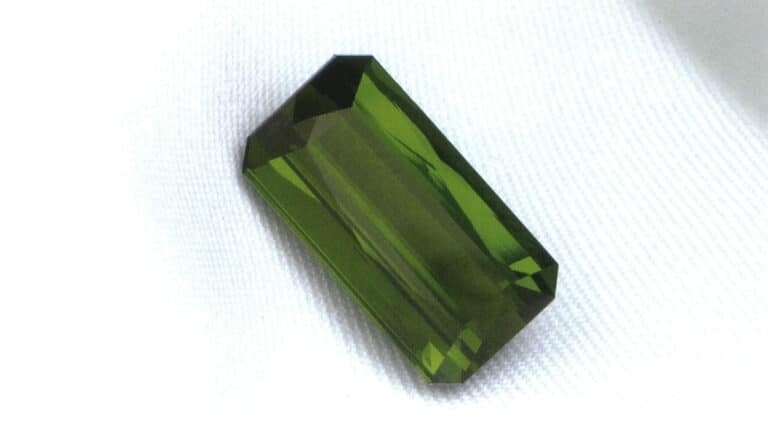
4. Dravite
Dravite dapat memiliki warna yang beragam, mulai dari sedikit berwarna kopi, kuning kecoklatan, hingga kuning tanah, dan popularitasnya tidak sebagus warna-warna lainnya. Batu ini paling sering ditemukan dalam ukuran 1-10 karat, dengan harga pasar US$15-47 per karat.

5. Tidak sopan
Seri biru turmalin berkisar dari biru muda hingga biru tua. Turmalin biru murni jarang ditemukan, sementara biru muda, yang menyerupai aquamarine berkualitas tinggi, adalah yang paling populer. Blue Beryl jarang melebihi 10 karat, dengan harga pasar US$47-109 per karat.

6. Schorl
Turmalin dengan kandungan besi yang tinggi tampak hitam, yang merupakan warna yang tidak disukai kebanyakan orang. Oleh karena itu, sebagian besar Schorl disimpan sebagai spesimen dan jarang dipotong menjadi batu permata.
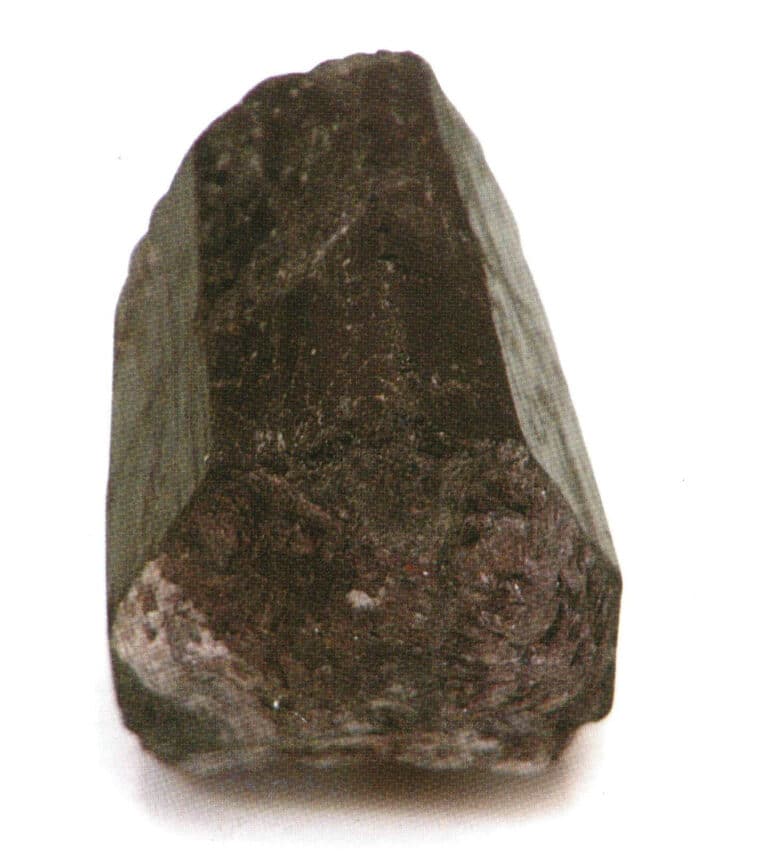
7. Turmalin Mata Kucing
Beberapa turmalin mengandung inklusi seperti jarum, dan jika dipoles di sepanjang sumbu vertikal (sumbu C) untuk membentuk cabochon, mereka akan menunjukkan efek mata kucing. Turmalin mata kucing umumnya ditemukan dalam varietas merah dan hijau. Mata kucing turmalin berkualitas tinggi jarang ditemukan, dan sebagian besar buram. Saat memilih mata kucing, carilah mata kucing dengan garis tipis, garis yang fleksibel saat diputar, dan garis yang tidak patah atau miring.
8. Turmalin Dua Warna
Turmalin dwiwarna, seperti namanya, memiliki dua warna dalam turmalin; biasanya, salah satu ujungnya berwarna merah, dan ujung lainnya berwarna hijau; ada juga varietas dwiwarna dengan salah satu ujungnya berwarna kuning dan ujung lainnya berwarna hijau. Sejak tahun 1995, negara-negara seperti Mozambik telah menghasilkan banyak turmalin dua warna. Harganya setinggi sepatu hak tinggi favorit wanita muda saat ini, dengan santai meminta 1 karat seharga US $ $93-125; jika warnanya berbeda, 1 karat dapat berharga lebih dari US $ $219-251; adapun yang bermutu tinggi, lebih dari 100 karat turmalin dwiwarna, harga per karatnya kemungkinan besar akan melebihi US $ $313.

9. Turmalin Semangka
Turmalin semangka seperti semangka: hijau di luar dan merah di dalam. Turmalin semangka jarang yang bersih dan indah. Ukurannya biasanya di bawah 10 karat, US$31-47 per karat.

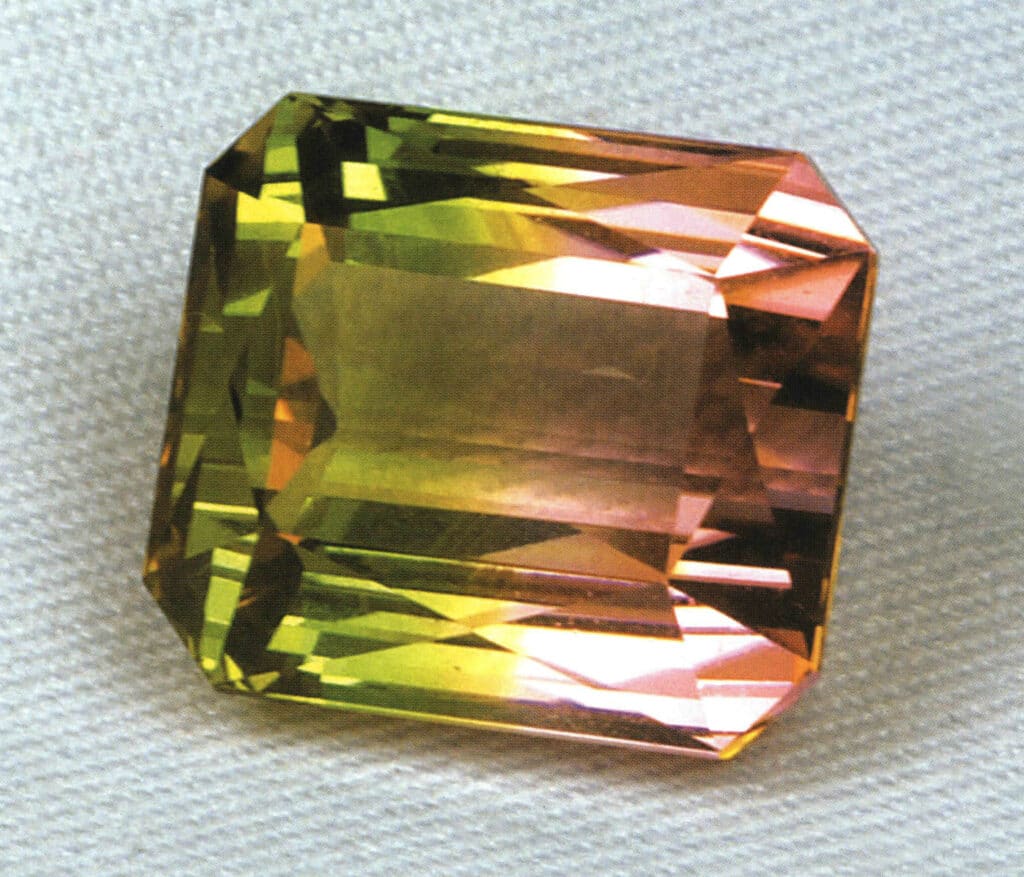
Selama itu adalah turmalin dua warna, banyak pedagang menyebutnya sebagai turmalin semangka.

Turmalin Semangka
10. Turmalin Alexandrite
Turmalin semangka berubah warna di bawah sumber cahaya yang berbeda, seperti sinar matahari dan lampu tungsten. Hal ini karena sinar matahari dan lampu tungsten menyerap panjang gelombang cahaya yang berbeda; sinar matahari kaya akan warna hijau atau biru, sedangkan lampu tungsten kaya akan cahaya merah. Oleh karena itu, turmalin tampak biru atau hijau di bawah sinar matahari atau lampu siang hari dan merah di bawah lampu tungsten. Turmalin Alexandrite sangat langka dan terutama dikoleksi oleh para kolektor permata.
Selain itu, sebelum tahun 1995, Mozambik menghasilkan sejumlah besar batu Tourmaline dengan berbagai macam warna, termasuk warna ungu tua yang sangat mirip dengan kecubung. Yang kecil berkisar dari beberapa persepuluh hingga 1-2 karat, yang sedang 5-20 karat, dan yang besar lebih dari 50-100 karat. Kejernihan dan kecemerlangannya bagus, dan harganya pun tidak murah, yaitu US$156-188.
11. Investasi dan Koleksi Turmalin
Selama ekonomi China berkembang, harga Tourmaline tidak akan turun! Oleh karena itu, disarankan jika Anda menemukan stok Beryl merah di pasaran di Taiwan di atas 10 karat, dengan harga di bawah 1 US $ 1.000.000, Beryl hijau di bawah US $ 1.000.000, dan Beryl dua warna di bawah US $ 1.000.000, ini adalah waktu yang tepat untuk membeli. Jika Anda ingin mengoleksi, semakin besar dan bersih, semakin baik; 10-20 karat adalah ukuran yang paling sering dibeli, dan lebih dari 30 karat dianggap sebagai target bagi para kolektor. Adapun warna Turmalin mana yang harus Anda dapatkan? Paraiba, turmalin dua warna, rubellite, dan Chrome Verdelite adalah pilihan yang baik, tetapi juga tergantung pada warna yang Anda sukai.
Apa itu Paraiba?
Ditemukan pada tahun 1989, batu ini dinamai sesuai dengan nama daerah Paraiba di Brasil tempat batu ini diproduksi. Karena adanya kandungan mangan, batu ini menampilkan warna biru-hijau tua, ungu-biru, dan bahkan warna hijau danau yang lebih jelas, membayangi warna zamrud, pirus, dan safir. Karena variasi warnanya yang luas, batu ini dikenal sebagai "pelangi biru" batu permata, dan merupakan salah satu yang termahal di dunia. Tidak mengherankan jika Paraiba berkualitas tinggi dapat berharga antara US$313-470 per karat. Dalam beberapa tahun terakhir, Mozambik juga telah memproduksi sejumlah Paraiba, tetapi warnanya lebih terang.
Turmalin biru harus mengandung besi dan tembaga, dan hanya turmalin biru yang mengandung tembaga dalam jumlah yang signifikan yang dapat disebut Paraiba. Saat ini, China Taiwan belum mengidentifikasi semua instrumen yang dapat membedakannya. Jika tidak dapat ditentukan apakah mengandung tembaga, itu hanya dapat disebut sebagai blue beryl, yang merupakan turmalin biru. Jika sebuah toko mengklaim bahwa itu adalah Paraiba, biasanya harus memiliki sertifikat GRS untuk jaminan. Untuk Paraiba Mozambik bersertifikat, harga pasar untuk 1 karat biasanya adalah US$251-470.

Bagian II Tanzanite
Tanzanite diproduksi di Tanzania. Batu tanzanite yang kasar sering ditemukan bersama dengan batu rubi, dan warnanya berkisar dari ungu-biru tua hingga ungu muda. Tanzanite yang paling mahal adalah yang memiliki rona biru dengan warna ungu. Dalam beberapa tahun terakhir, batu ini sangat dihargai oleh Tiffany & Co, sehingga sangat dicari di pasar. Menurut survei majalah, pada tahun 2001, total volume penjualan tanzanite berada di peringkat ketiga, hanya di belakang safir dan mutiara, menjadikannya batu permata yang sangat populer dalam beberapa tahun terakhir, dengan nilainya yang sebanding dengan safir dan zamrud berkualitas tinggi. Alasan mengapa tanzanite menjadi komoditas panas di pasar adalah karena produksinya yang terbatas, potensi kenaikan harga yang tinggi di masa depan, dan bahkan dapat menyaingi batu safir yang indah, sehingga menjadi favorit di antara banyak investor dan kolektor.
| Komposisi | Sistem kristal | Kekerasan | Gravitasi Spesifik | Indeks refraksi | Warna | Pembelahan | Patah tulang |
|---|---|---|---|---|---|---|---|
| Ca2Al3O | sistem kristal rhombohedral | 6.5 | 3.35 | 1.69 ~ 1.70 | Merah Muda, Kuning, Coklat, Hijau, Biru | Resolusi permukaan aksial lengkap | Semi-kerak |
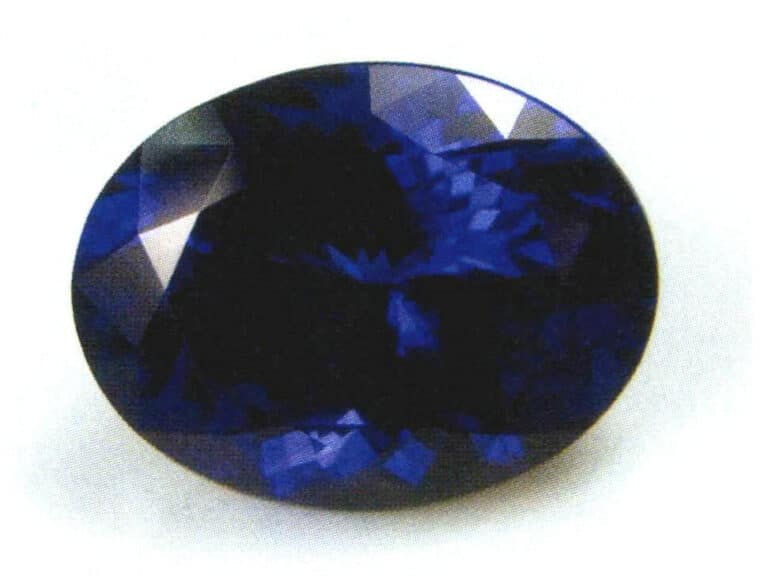
Di Amerika Serikat, harga tanzanite dikategorikan dengan sangat baik, dengan nilai yang dibagi menjadi AAA, AA, dan A, dan harganya tinggi. Pada satu titik, produksi sempat terhenti karena banjir di Tanzania, menyebabkan harga melambung tinggi, tetapi kemudian, karena kemerosotan ekonomi, harga berangsur-angsur menurun. Umumnya, tanzanite di bawah 5 karat tidak dianggap signifikan, dan tergantung pada perbedaan warna dan kecemerlangan, harga di bawah US$219 dianggap murah; untuk tanzanite dengan ukuran 5-9 karat dan kualitas terbaik, harga di bawah US$282 dianggap wajar; untuk tanzanite dengan ukuran 10-19 karat, harga berkisar antara US$376-407; untuk 20-29 karat, harga 1 karat adalah US$439-470; untuk ukuran di atas 30 karat, harga 1 karat adalah sekitar US$470-564.
Ukuran karat tanzanite lebih besar daripada safir. Jika Anda ingin berinvestasi, disarankan untuk membeli tanzanite di atas 20 karat; untuk dipakai, kebanyakan orang memilih batu permata sekitar 10 karat. Pembeli di China biasanya tidak peduli dengan harga; semakin besar ukurannya, semakin baik. Mengambil tanzanite 30 karat sebagai contoh, mereka mengutip US $ $470 per karat, dengan total sekitar US $ $14120. Harga ini hanya dapat membeli berlian GIA 1 karat dengan kadar (E, VVS) (15.400 USD) atau (D, VVS2) (15.500 USD) dengan potongan harga 10% atau membeli safir Sri Lanka seberat 6 ~ 8 karat. Selain itu, asal usul tanzanite cukup langka, dan semakin banyak orang kaya di China. Selama 10.000 orang kaya membelinya, bisa dibayangkan berapa harga tanzanite di atas 20 karat akan naik. Diperkirakan dalam 5 tahun, tanzanite di atas 30 karat akan sangat sulit ditemukan, dan harga per karatnya bisa mencapai US $ $627-941, yang bukan tidak mungkin. Jika ekonomi di China tumbuh lebih cepat, kecepatannya akan lebih cepat lagi, jadi teman-teman yang ingin berinvestasi di tanzanite.
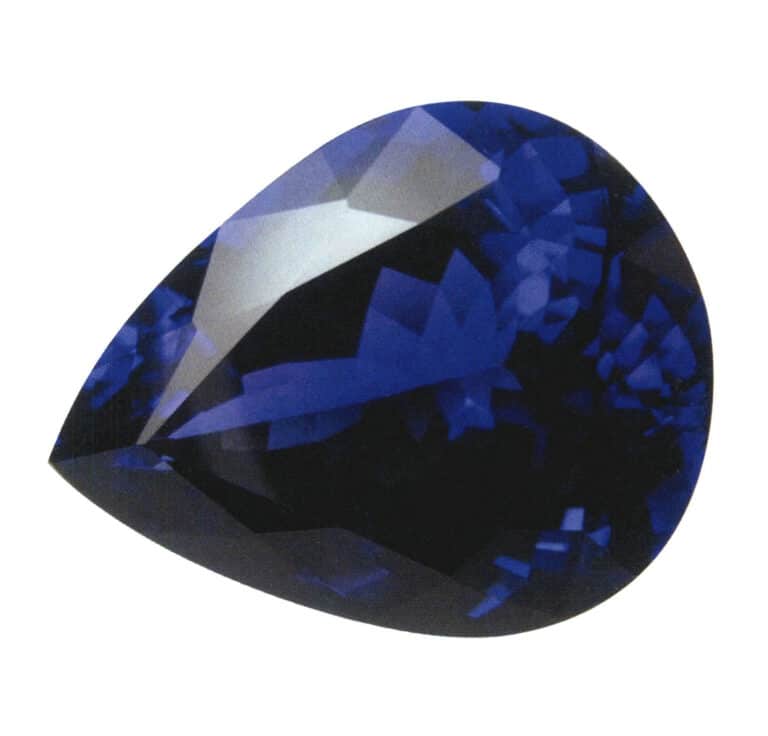
Bagian III Kristal
Kristal telah lama digunakan sebagai batu permata dan dekorasi. Gugusan kristal dapat digunakan sebagai ornamen, dan kristal dapat dipoles menjadi bola kristal, diukir menjadi perhiasan kristal, dan dibuat menjadi berbagai cincin kristal, anting-anting, dan liontin. Kristal yang mengandung inklusi (seperti empedu air, klorit, turmalin, pirit, dll.) adalah koleksi terbaik bagi para penggemar. Bentuk-bentuk unik (seperti Tulang punggung, tongkat, ujung berkepala dua, kristal kembar Jepang, dll.) juga menjadi favorit para kolektor. Orang Barat sangat percaya bahwa roh tersembunyi di dalam kristal, dan orang-orang menatap bola kristal untuk meramal atau memprediksi masa depan. Kristal dapat digunakan secara industri untuk membuat lensa kacamata, kaca pembesar, mikroskop, lensa kamera, dll., yang memiliki banyak fungsi. Selama lebih dari 20 tahun, Cina telah mementaskan legenda kristal, begitu gilanya hingga orang asing pun tak kuasa menahan kekagumannya. Toko-toko kristal yang berjejer di sepanjang jalan dan gang-gang menyatakan bahwa era kristal telah tiba.
| Komposisi | Sistem kristal | Kekerasan | Gravitasi Spesifik | Indeks refraksi | Warna | Pembelahan | Patah tulang |
|---|---|---|---|---|---|---|---|
| SiO2 | Sistem kristal heksagonal | 7 | 2.65 | 1.544 ~ 1.553 | Biru, hijau, hitam, merah muda, dll. | Kelas rendah | Berbentuk cangkang |
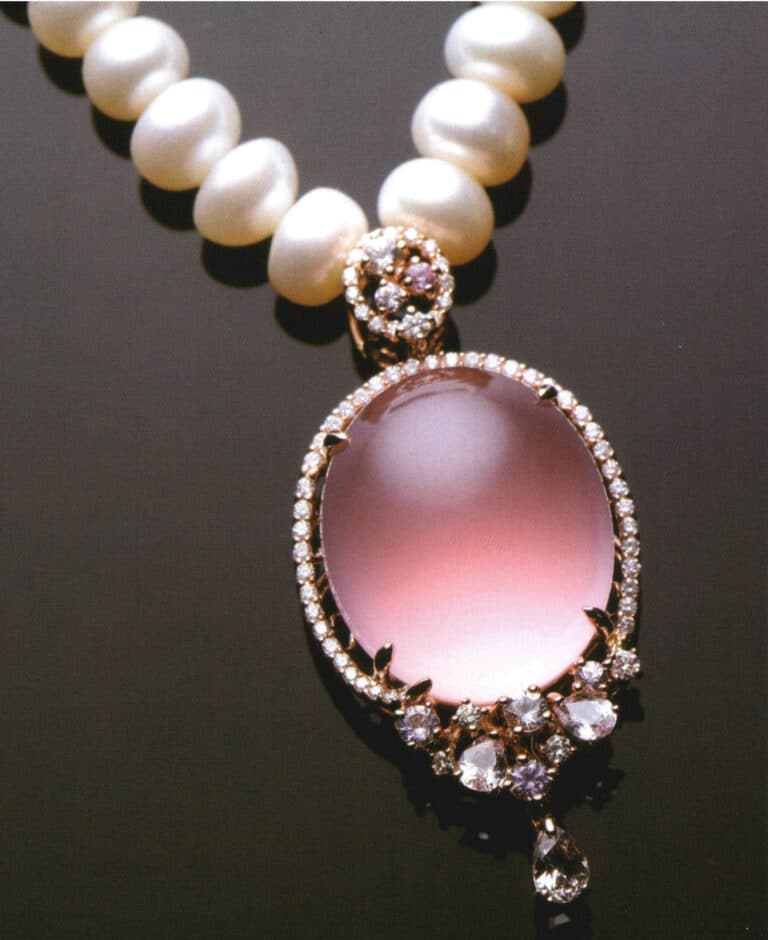
1. Sifat mineral
Apabila kristal dikenai tekanan, maka akan menghasilkan listrik, dan apabila diberi energi, maka akan menghasilkan getaran; jam tangan dan jam kuarsa dibuat dengan menggunakan sifat kristal ini. Bentuk kristal kuarsa biasanya berupa kolom heksagonal dengan ujung runcing, dan permukaan kolom biasanya memiliki tekstur pertumbuhan yang paralel. Inklusi biasanya berupa rutil, mika, klorit, aktinolit, klorokristalin, turmalin, dll., dan terkadang ada kristal yang melilit kristal.
Kristal dapat dikategorikan menjadi Kuarsa Kristal Kasar (Kuarsa Kasar), yang partikel kristalnya dapat dilihat dengan mata telanjang, dan Kuarsa Mikrokristal (Mikrokristal), yang partikel kristalnya hanya dapat dilihat melalui mikroskop. Kuarsa Kristal Kasar memiliki kristal putih, kecubung, citrine, kristal berasap, kuarsa merah muda, aventurin, dll.; Kuarsa Mikrokristal memiliki batu akik, kalsedon, mata harimau, jasper, kayu silika, dan batu api, dll..
1.1 Kuarsa kasar
Kristal Batu
Kristal adalah kuarsa dengan sisi-sisi kristal dan merupakan yang paling sering dilihat oleh masyarakat umum. Kuarsa putih dapat tumbuh secara individual, tetapi biasanya tumbuh dalam kelompok dan kadang-kadang hidup berdampingan dengan mineral lain seperti pirit. Ketika dua kristal tumbuh bersama dan tidak dapat dipisahkan, maka disebut kembar. Ada dua jenis kembar kuarsa; yang paling umum adalah Kembar Interpenetran, sementara yang lainnya adalah kembar kontak, di mana dua kristal bersentuhan selama pembentukannya. Ketika kristal memiliki dua titik penghentian, pedagang Amerika menyebutnya Herkimer Diamond (dikenal sebagai kuarsa berlian).
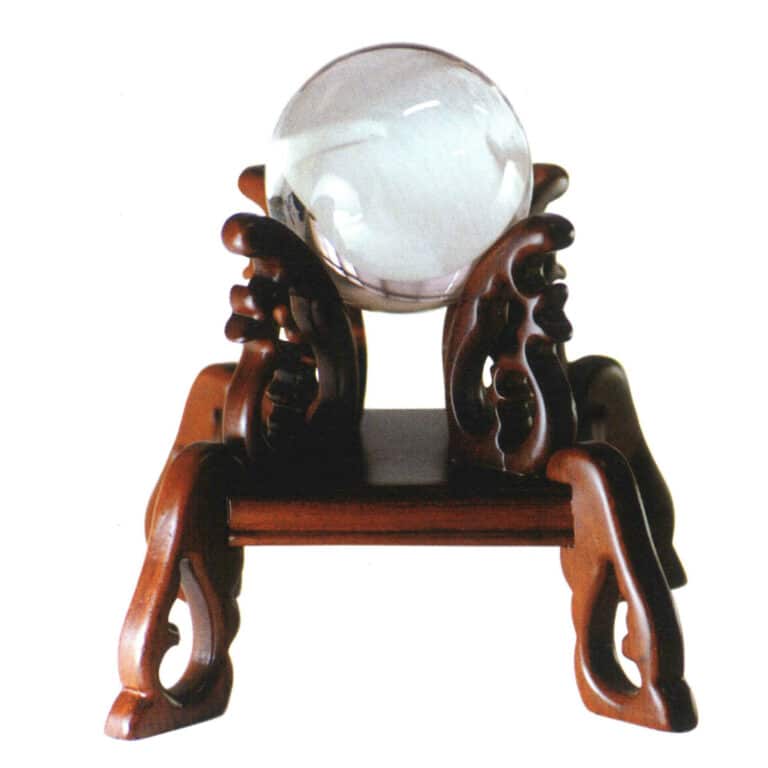

Menghubungi Kembar
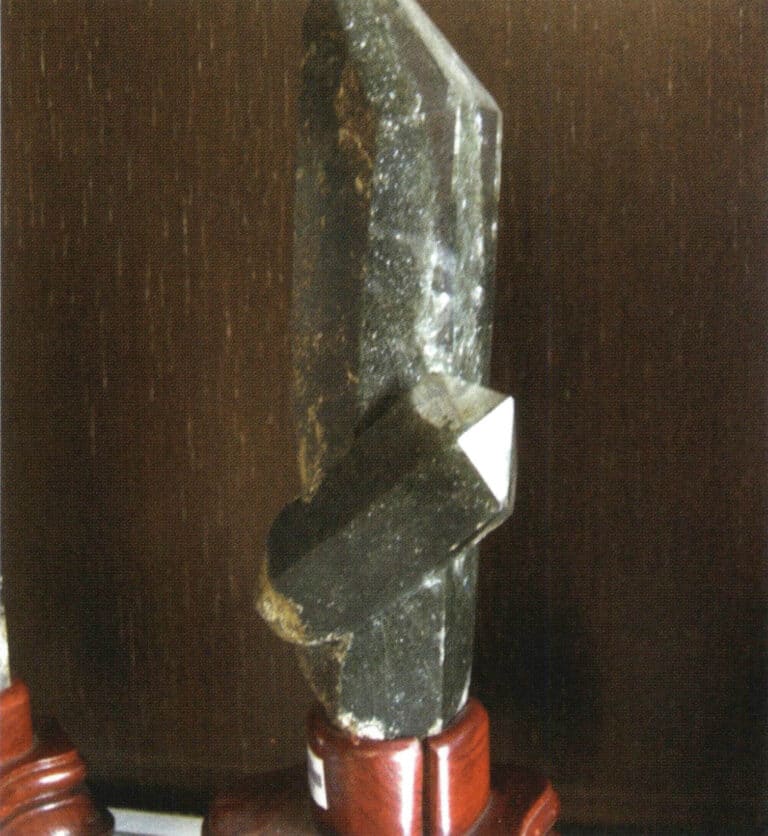
Kembar Interpenetran
Amethyst
Kecubung adalah warna yang paling mulia di antara kristal. Di masa lalu, kebanyakan orang percaya bahwa warnanya ungu karena kandungan mangan, tetapi penjelasan yang dapat diandalkan saat ini adalah bahwa hal itu disebabkan oleh zat besi. Daerah produksi utama Amethyst adalah Brasil, Madagaskar, Zambia, dan Uruguay. Operator domestik terutama mengimpor dari Brasil, sementara batu kecubung yang diproduksi di Zambia, yang memiliki warna kebiruan, dianggap sebagai yang terbaik di antara batu kecubung.
Kecubung biasanya memiliki ujung runcing dengan bentuk rhombohedral dan tidak memiliki permukaan prisma, tetapi bagian ungu sering kali hanya pada ujungnya, dengan warna yang sering kali terdistribusi dalam bentuk pita. Kecubung berwarna terang yang dipanaskan hingga 400-500 ℃ akan berubah menjadi kuning kecoklatan atau bahkan hijau; ketika dipanaskan di atas 5750 ℃, ia akan menjadi tidak berwarna. Sebagian besar citrine yang beredar di pasaran adalah batu kecubung, yang telah diubah dengan pemanasan.
Citrine
Alasan utama untuk warna kuning citrine adalah kehadiran zat besi. Sumber utama citrine adalah Brasil, Madagaskar, Rusia, Amerika Serikat, dan Spanyol. Jenis lainnya, ametrine, yang berwarna setengah kuning dan setengah ungu, ditemukan di Bolivia. Citrine gelap menunjukkan pleochroism, tetapi citrine yang sudah diberi perlakuan panas tidak menunjukkan dikroisme. Citrine yang diberi perlakuan panas biasanya mengisyaratkan warna merah, sedangkan citrine alami biasanya berwarna kuning muda.
Kuarsa Berasap
Kuarsa berasap, yang berwarna hitam kecoklatan seperti asap, biasanya disebabkan oleh elemen radioaktif. Negara-negara yang memproduksi kuarsa berasap termasuk Korea Selatan, Rusia, Brasil, dan Madagaskar. Paparan elemen radioaktif dapat merusak struktur atom kuarsa, sehingga membuatnya buram. Sebagian besar kuarsa berasap yang ada di pasaran dihasilkan oleh radiasi kuat dari reaktor nuklir, dan kuarsa transparan dapat dengan cepat berubah menjadi kuarsa berasap setelah disinari.
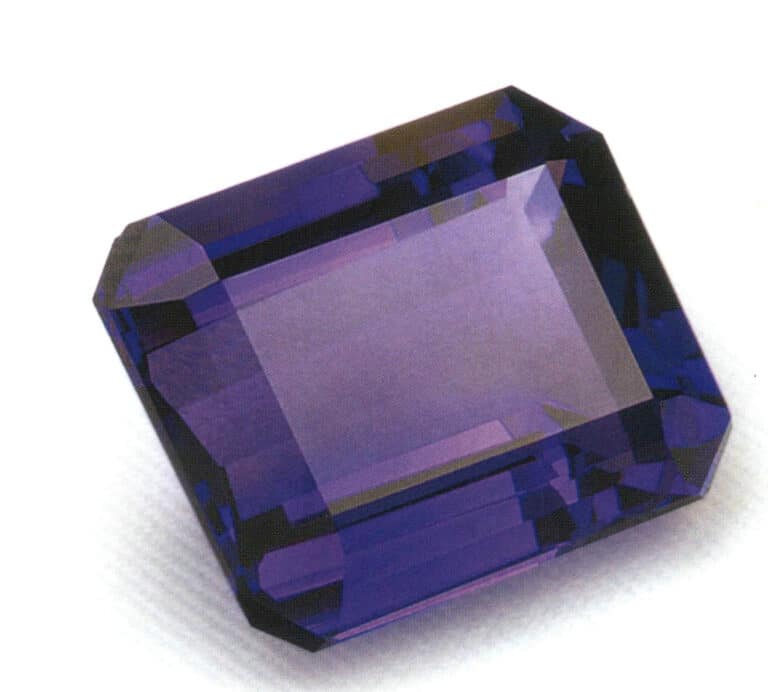
Amethyst
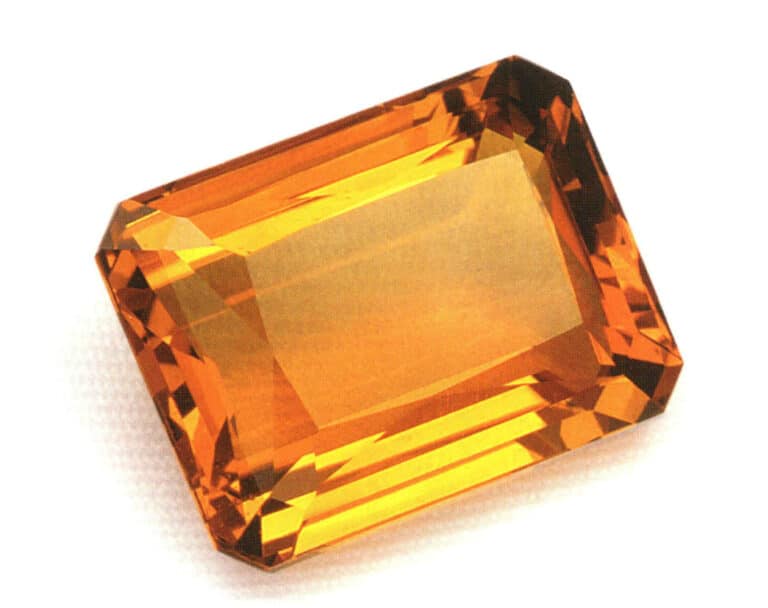
Citrine
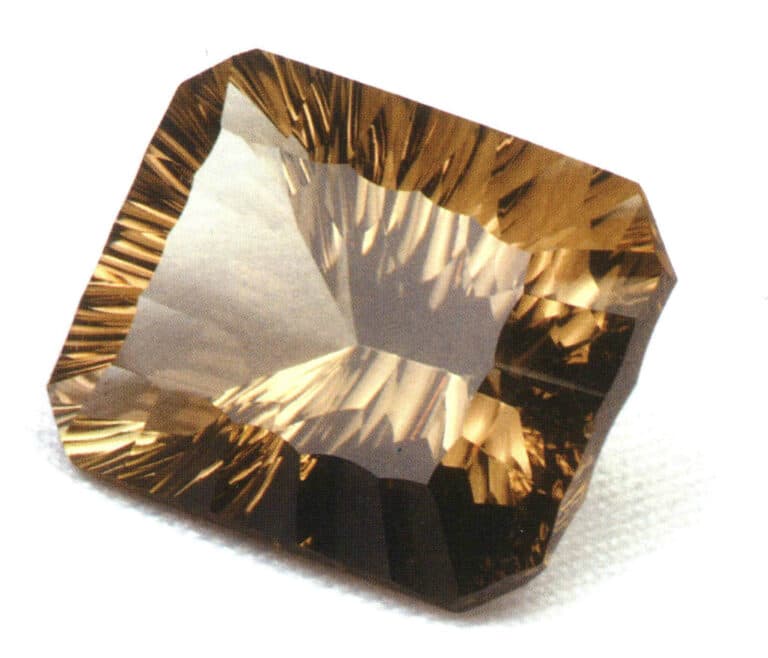
Kuarsa Berasap
Kuarsa Mawar
Rose Quartz, juga dikenal sebagai kuarsa merah muda, berwarna merah muda, dan warnanya disebabkan oleh adanya titanium. Jika memiliki permukaan kristal, itu disebut kristal mawar, tetapi sebagian besar di pasaran masih kuarsa mawar. Ada banyak produk kuarsa mawar di granit Great Crystal di New York, AS. Kuarsa Jinwei biasanya dipoles menjadi bola atau bentuk hati, yang melambangkan cinta abadi.
Aventurine
Aventurine mengandung mika atau hematit berwarna hijau atau coklat kemerahan di dalam kristal. Aventurine palsu yang umum beredar di pasaran terbuat dari kaca dengan potongan tembaga merah murni, tetapi dapat dengan mudah dikenali dengan kaca pembesar.
1.2 Kuarsa mikrokristalin
Batu akik
Jenis kuarsa mikrokristalin berpita, biasanya mengisi rongga di dalam batu (geode). Jika geode mengandung air yang mengkristal, maka disebut batu akik air. Struktur berpita di tepi geode adalah karakteristik batu akik. Banyak negara yang memproduksi batu akik, seperti India, Amerika Serikat, Jerman, dan Meksiko, dengan Brasil sebagai produsen terbesar. Karena produksi batu akik Brasil yang besar, harganya lebih rendah daripada kristal. Batu akik biasanya dipotong menjadi irisan-irisan kecil, digunakan sebagai layar kecil atau dirangkai menjadi lonceng angin kecil, dipoles menjadi pemberat kertas, dll. Sebagian besar potongan batu akik yang tersedia secara komersial diwarnai, dan area yang diwarnai menunjukkan endapan pigmen, yang dapat dilihat dengan kaca pembesar. Jenis batu akik lainnya termasuk Batu Akik Pelangi, Batu Akik Api, dan Onyx.
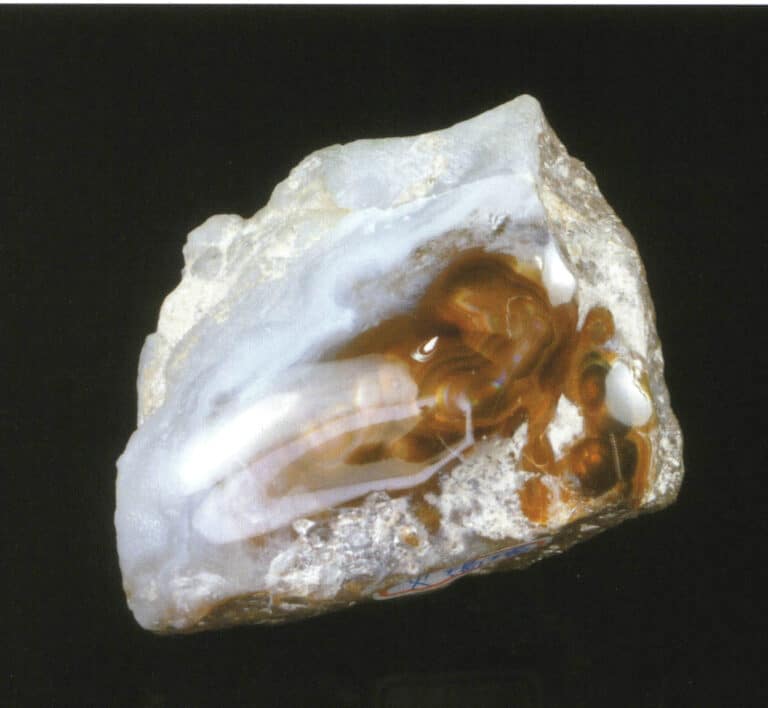
Kalsedon
Kalsedon biasanya transparan atau buram dan mengandung sedikit air. Kalsedon yang mengandung tembaga dan tampak biru disebut kalsedon biru, dan harganya tidak murah. Orang Jepang khususnya menyukai kalsedon biru. Beberapa kalsedon biru dari daerah pertambangan tertentu rentan terhadap dehidrasi dan perubahan warna, karena itulah toko perhiasan sering merendam kalsedon di dalam air untuk mencegah keretakan akibat dehidrasi.
China Taiwan masih memiliki pertambangan, tetapi kalsedon biru yang biasa terlihat di China Taiwan sebagian besar diimpor dari Amerika Serikat dan Indonesia. Saat ini, tiga harta karun China Taiwan adalah kalsedon biru, koral, dan mata kucing giok China Taiwan, yang juga menjadi oleh-oleh favorit para pelancong China. Selain kalsedon biru, ada juga kalsedon merah coklat kemerahan, yang paling terkenal dari India; kalsedon hijau (Chrysoprase), yang tampak hijau apel karena nikel, diimpor dari Australia dan sering disalahartikan sebagai batu giok, oleh karena itu disebut juga "giok Australia". Produksi juga dilakukan di California, Amerika Serikat, dan Jerman.
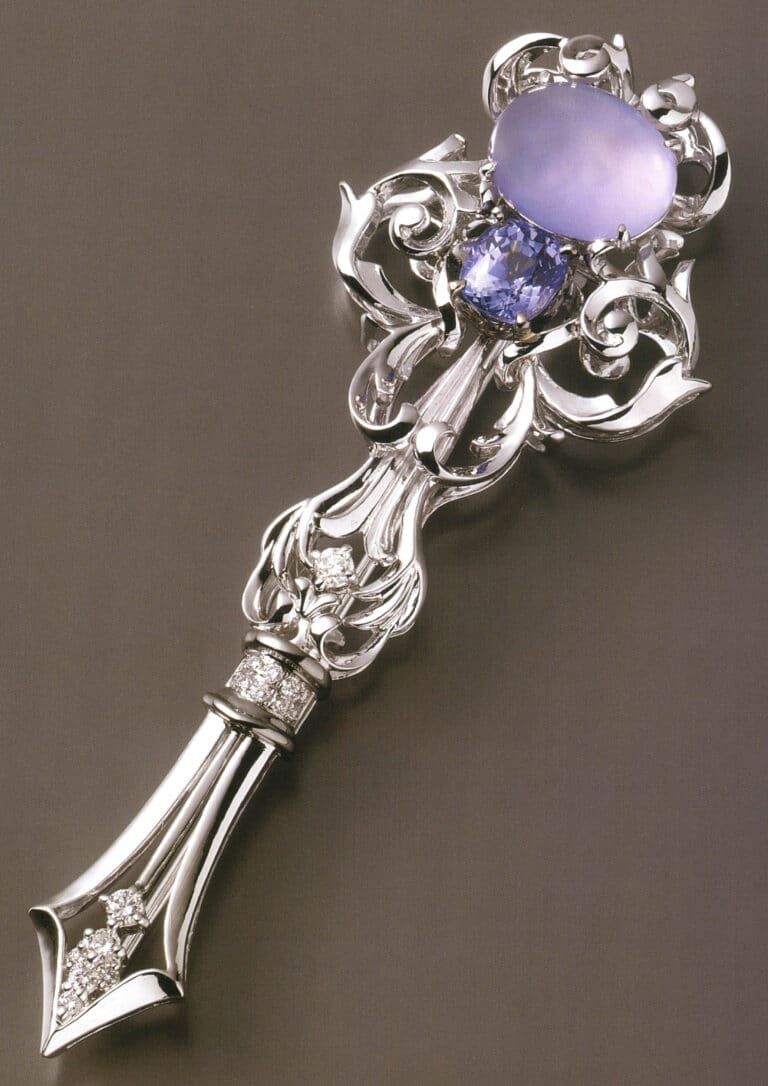
Pin Kerah Pria Kalsedon Ungu Tembus Pandang Tinggi, WANG CHEN LING Seri Wewangian Ivan, anggur merah Desain dan produksi.

Di mana ada garis-garis, itu disebut batu akik, dan di mana tidak ada garis, itu disebut kalsedon.
Mata Harimau.
Hal ini disebabkan oleh penggantian asbes berserat dengan silikon dioksida, yang mempertahankan struktur berserat. Mata harimau yang paling umum berwarna cokelat atau kuning. Mata harimau biru kadang-kadang disebut mata elang, dan terutama diproduksi di Afrika Selatan. Satu set gelang mata harimau berharga US $ $9-15.
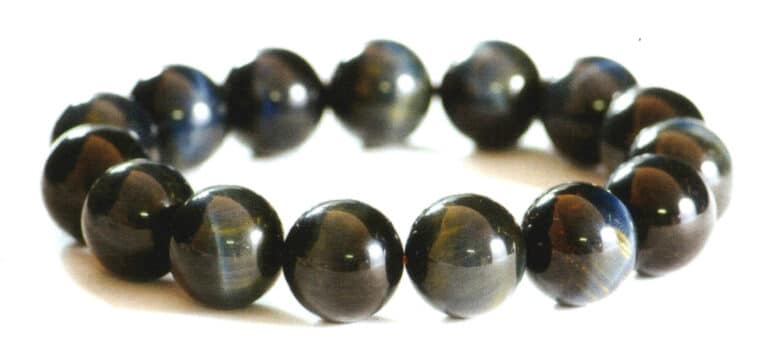
Gelang manik-manik mata elang

Gelang manik-manik Mata Harimau
Jasper.
Ini adalah jenis kuarsa mikrokristalin merah yang mengandung hematit. Jasper umumnya buram, dengan rekahan seperti cangkang, dan penampilannya menyerupai batu bata merah. India, Amerika Serikat, Rusia, Venezuela, dan negara-negara lain adalah area produksi utama. Sebuah kerajinan segel berharga US$6-9.
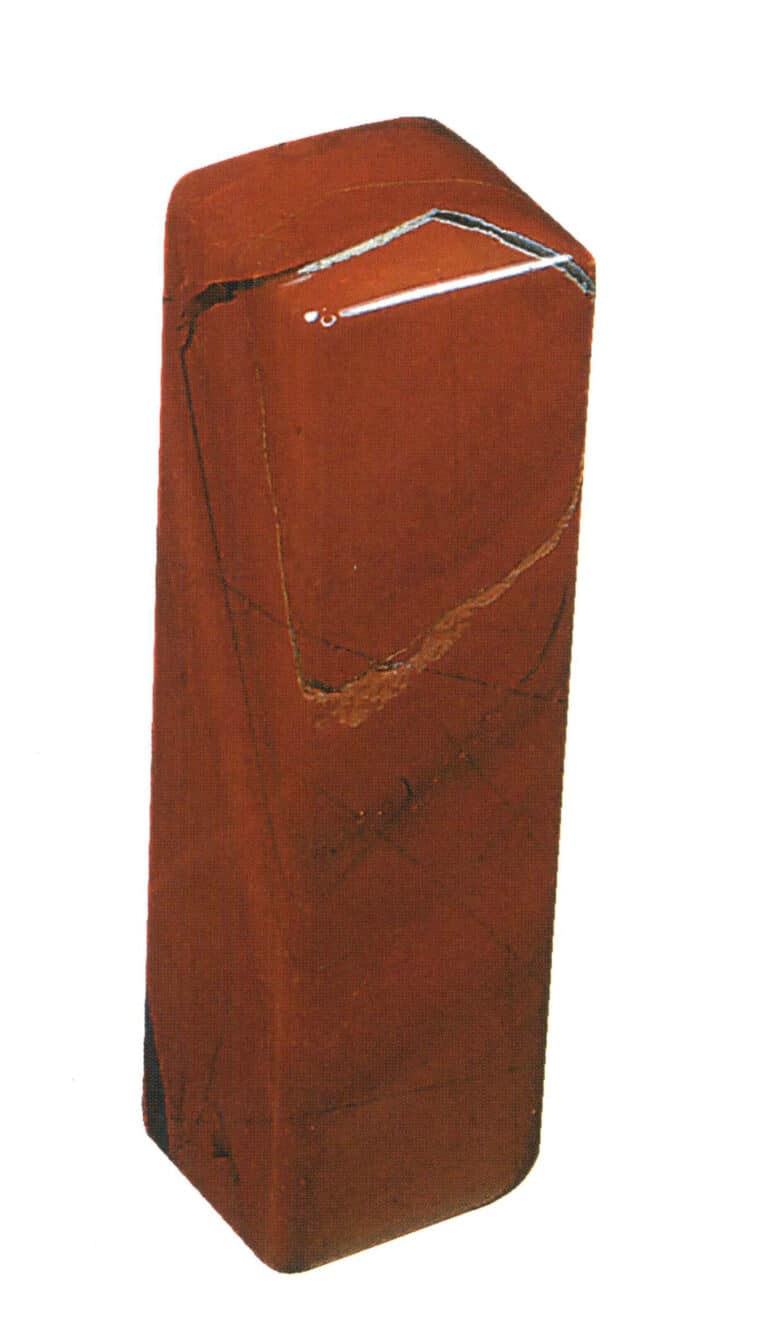
Chert
Chert putih digunakan pada zaman kuno sebagai penyulut api, sementara Chert hitam dibuat menjadi mata panah, pisau, dan kapak. Batu ini tidak memiliki nilai sebagai batu permata.
Kayu Silikat
Juga dikenal sebagai kayu yang membatu, kayu ini terbentuk karena pergerakan tektonik, di mana kayu terkubur jauh di bawah tanah, dan silika dalam air tanah mengalami proses penggantian untuk membentuknya. Banyak produsen di China mengimpor kayu silika dari Indonesia untuk membuat meja batu, kursi batu, dan perabotan atau ornamen lainnya.
Karakteristik batu akik kalsedon
| Nama | Alasan pewarnaan | Tempat asal | Catatan |
|---|---|---|---|
| Kalsedon biru | Tembaga, perunggu silikon | Cina Pegunungan Pesisir Taiwan, Amerika Serikat, Indonesia | Dehidrasi mudah kehilangan warna |
| Cornelian | Hematit atau magnetit | Yang paling terkenal di India | / |
| Chrysoprase | Ni | Australia, California, Amerika Serikat, Jerman | Juga dikenal sebagai giok Australia, meniru batu giok |
| Kalsedon berwarna | / | / | Pita berwarna merah, biru, dan cokelat |
| Batu akik api | Limonit | California, Amerika Serikat | 1. Berubah warna seperti opal 2. Memiliki api merah, hijau, biru, dan ungu |
| Onyx | Panci oksida hitam atau oksida besi merah | / | Bentuk cabang pohon atau pemandangan lanskap |
Karakteristik lain dari kuarsa
| Nama | Alasan pewarnaan | Tempat asal | Catatan |
|---|---|---|---|
| Gua Kristal | / | Brasil | 1. Lapisan terluar adalah batu akik, berongga, dengan banyak kristal di sepanjang bagian luarnya. 2. Biasanya berbentuk bulat atau oval. |
| Mata harimau | Kuarsa menggantikan asbes dengan tetap mempertahankan struktur aslinya. | Afrika | 1. Mata harimau berwarna kuning atau kuning kecokelatan. 2. Varietas biru disebut mata elang. |
| Jasper. | Mengandung hematit mikrokristalin dan kuarsa | India, Venezuela, Amerika Serikat, Rusia | Hadir dalam warna merah dan hijau, yang dikenal sebagai "Darah dan Hati" atau "Rumput Harum yang Menghubungkan Langit" |
2. Harga kristal terungkap
Kebanyakan orang tahu tentang kristal mulai dari "efek penyembuhan" mereka: batu kecubung dapat meningkatkan kebijaksanaan, citrine dapat menarik kekayaan, dan kuarsa mawar dapat menarik cinta, yang hampir diakui secara universal. Mengenakan kristal juga memiliki berbagai tujuan; beberapa orang melakukannya untuk berlatih qigong, beberapa untuk kultivasi spiritual, dan beberapa hanya untuk keindahannya. Karena kristal tidak mahal, hanya sedikit orang yang menaksirnya, karena biaya penaksiran biasanya satu hingga dua ribu dolar New China Taiwan setiap kali. Sebaliknya, ornamen kristal sering kali bisa dibeli seharga US$9-31. Namun demikian, seandainya Anda membeli bola kristal seharga beberapa ribu dolar. Dalam hal ini, bola kristal tersebut harus dinilai dengan menggunakan spektroskopi inframerah untuk memeriksa apakah kristal tersebut sintetis.
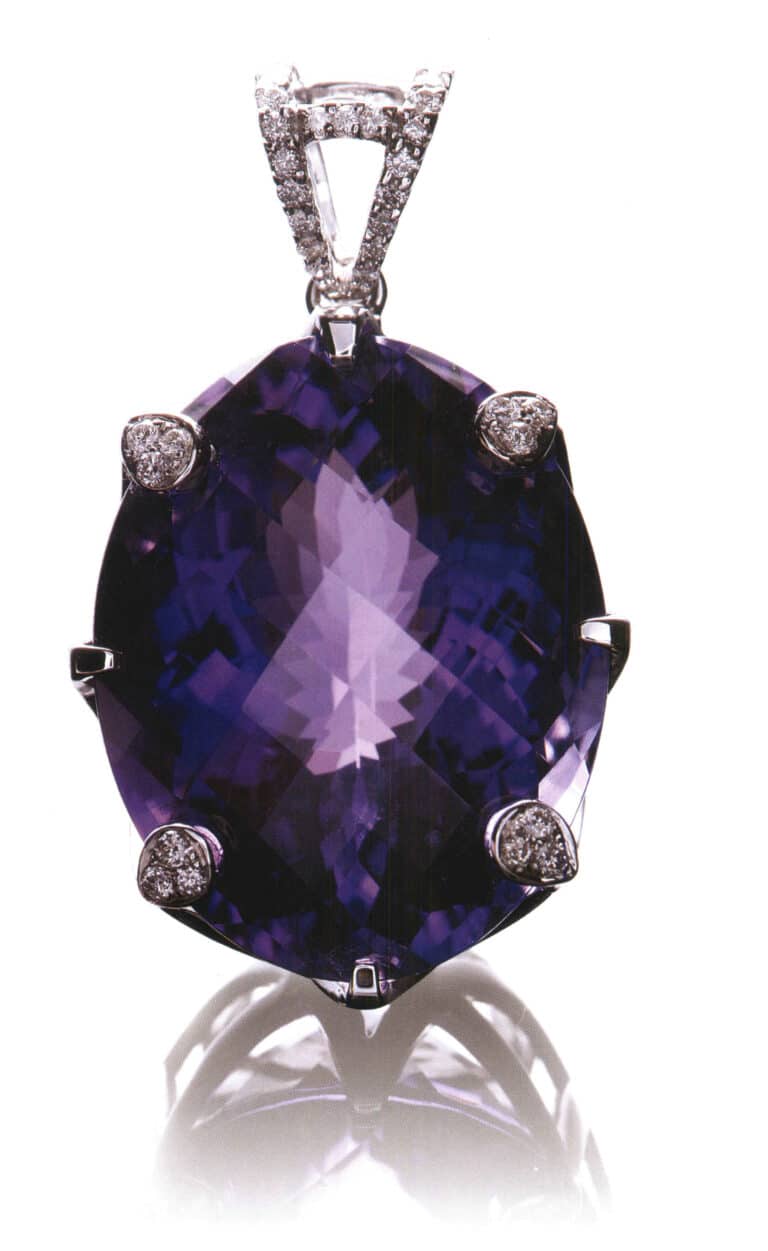
Di antara berbagai jenis kristal, kuarsa mawar, kecubung, dan citrine selalu menjadi yang terlaris. Kuarsa mawar bintang, khususnya, sangat disukai oleh para wanita. Kunci untuk memilih kuarsa mawar adalah semakin merah muda dan transparan, semakin mahal harganya, dengan harga yang dihitung per karat. Kuarsa mawar dengan berat 1 karat berharga US$0.9-1.5, sedangkan kuarsa mawar bintang berharga US$1.5-6.2. Gelang kuarsa mawar yang tidak tembus cahaya berharga US$6.2-15.

Ketika membeli batu kecubung, kita harus melihat keseragaman warnanya; semakin tidak berdasar dan seragam warnanya, tanpa kotoran, semakin tinggi harganya. Kecubung dari Brasil umumnya lebih murah daripada dari Uruguay. Batu kecubung umumnya dipotong menjadi liontin, manik-manik, gelang, kalung, dan ukiran, dengan harga US $ $2,5-6,2 untuk 1 karat, dan gelang batu kecubung berharga antara US $ $15-94.
Sedangkan untuk citrine, juga terdapat variasi dalam kedalaman warna, tetapi kebanyakan citrine dibentuk dengan memanaskan batu kecubung untuk mengubah warnanya, dan penjual pada umumnya akan mengindikasikan "perlakuan panas", sehingga lebih murah daripada citrine alami.
Kristal kuning alami berharga US$3-7. Selain itu, ada juga jenis giok kuning yang tampak kuning lemon, yang dikenal sebagai kristal lemon, yang memiliki daya bakar yang sangat baik tetapi lebih murah daripada kristal kuning, dengan harga US$1.2-3.1 per karat. Baik itu kuarsa mawar, kecubung, atau kristal kuning, beberapa dapat mencapai US$6.2-9.4, tetapi harganya tidak terlalu mahal, bahkan dengan ukuran karat yang lebih besar.
Selain dibuat menjadi perhiasan, geodes batu kecubung dan geodes batu giok kuning adalah gaya yang populer. Kebanyakan orang tertarik dengan "efek terapeutik" untuk meningkatkan medan magnet. Dikatakan bahwa Miliarder Wang Yongqing suka menempatkan batu kecubung di kantornya semasa hidupnya, yang berkontribusi pada kesehatannya yang kuat. Dukungan dari seorang selebriti juga telah mendorong popularitas geode kecubung. Saat memilih batu kecubung, perhatikan warna dan ukuran kristal. Umumnya, mereka dihargai per kilogram. Sebagai contoh, geode batu kecubung Brasil berharga US$14-62; geode batu kecubung ungu tua berkualitas lebih tinggi dari Uruguay berkisar antara US$62-94 per kilogram (sekitar US$13-20). Geodes giok kuning umumnya diperoleh dengan memanaskan geodes kristal ungu untuk mengubah warnanya, dengan harga US$18-37 per kilogram.
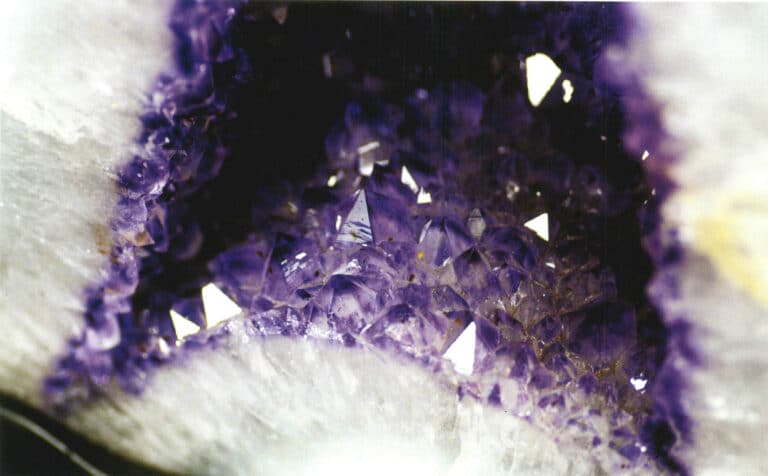
Selain itu, kristal ungu-kuning juga menjadi tren di kalangan desainer, terutama yang diolah dengan panas, dengan harga US$4,7-9,4 per karat; kuarsa berasap, yang juga dikenal sebagai kristal hitam, adalah yang termurah di antara kristal lainnya, dengan harga US$0,6-1,5 per karat (sekitar 5-11 Yuan Tiongkok).
Termasuk rutil, yang tampak sebagai kristal seperti jarum seperti rambut, juga merupakan salah satu produk terlaris. Industri biasanya menggunakan "kristal penuh" untuk menggambarkan kristal rambut yang penuh dengan rambut, semakin penuh harganya semakin mahal! Biasanya dibuat menjadi gelang, gelang, rantai manik-manik, liontin, cincin, dll., yang dihargai dalam satuan gram dan berkisar dari puluhan hingga ribuan dolar. Liontin kristal lengkap dihargai US$94-313; gelang kristal lengkap juga berharga US$156-470.

Kecubung dan citrine
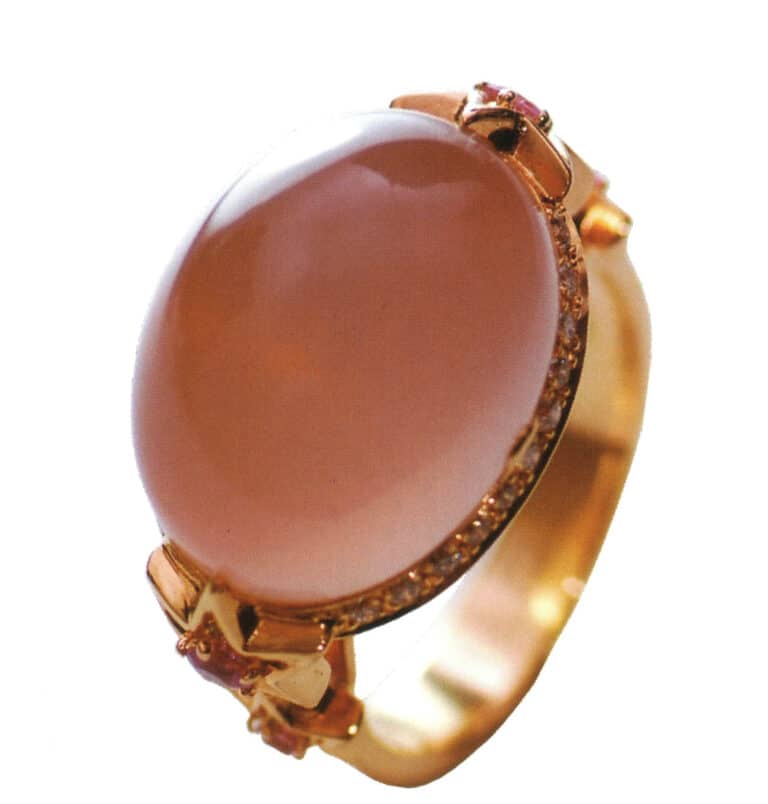
Cincin kuarsa mawar
Ada juga jenis kristal baru yang disebut "hantu hijau", yang menampilkan gambar menyerupai hantu hijau atau gunung palsu karena adanya klorit di dalam kolom kristal. Kristal hantu hijau sebagian besar dibuat menjadi liontin atau ornamen dan dapat dibeli dengan harga beberapa ratus hingga satu atau dua ribu yuan.

Liontin Momok Hijau
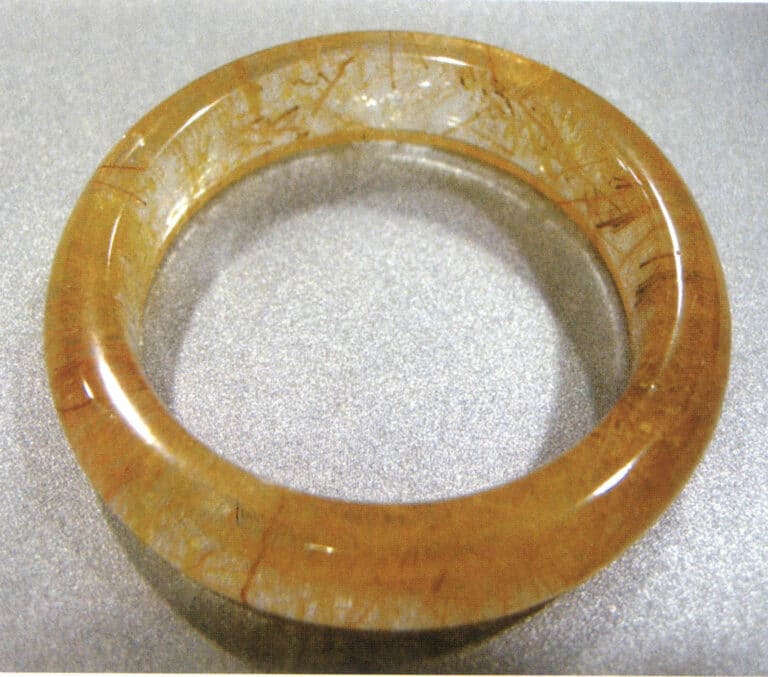
Gelang Kristal Titanium Rambut Kuning Alami
3. Pengetahuan Umum tentang Kristal Asli dan Palsu
Pertanyaan yang paling sering ditanyakan adalah bagaimana cara membedakan antara kristal asli dan palsu, yang juga menjadi perhatian banyak konsumen.
Kristal yang umum di pasaran termasuk kristal alami, kristal berwarna artifisial, dan kristal sintetis. Karena meningkatnya permintaan akan kristal alami, kristal yang diwarnai secara artifisial dan kristal sintetis menjadi lebih umum, dan kristal metode hidrotermal juga muncul. Kristal yang disintesis dengan metode ini dicirikan oleh transparansi dan kejernihannya, mirip dengan kaca. Kristal berwarna artifisial termasuk kristal hijau, kuning, dan ungu; kristal sintetis termasuk kristal tidak berwarna, ungu, dan kuning. Karena kondisi pembentukannya sama, maka, sulit untuk membedakan di antara keduanya.
Secara umum, kristal tak berwarna alami jernih dan transparan, mengandung inklusi gas-cairan di dalam kristal, dengan dinding bagian dalam gelembung yang tidak rata, kilau lembut, dan kemurnian rata-rata. Kecubung alami memiliki warna yang tidak merata, menampilkan distribusi serpihan yang tidak teratur, dan mengandung inklusi gas-cairan. Kristal berwarna artifisial memiliki warna yang seragam, dan kelompok warna serpihan yang tidak beraturan tidak terlihat di dalam kristal; kristal sintetis memiliki karakteristik yang mirip dengan kristal alami, tetapi kristal sintetis memiliki warna yang seragam, dengan inti kristal serpihan di bagian tengah dan kekerasan dan kepadatan yang lebih rendah. Ada juga jenis kaca kristal yang umum di pasaran, yaitu kaca yang dibuat dengan tambahan timbal, sehingga lebih berat daripada kaca biasa. Selain itu, karena pembiasan ganda kristal, sebuah garis bisa terlihat terbelah menjadi dua garis di bawah bola kristal (semakin besar bola kristal, semakin mudah dilihat).
Semua orang tahu bahwa ketika batu permata terbentuk di alam, beberapa kotoran atau inklusi sering kali terperangkap di dalam kristal, jadi kita harus berhati-hati tentang apakah kristal yang transparan dan tanpa cela itu buatan manusia.
Bagian IV Opal
Nama "opal" berasal dari kata Sansekerta Upala (yang berarti batu permata) atau kata Latin Opaius (yang berarti kumpulan batu permata). Sejarah opal penuh warna dan beragam seperti warna yang dipancarkannya. Sarjana Romawi, Pliny, menggambarkan opal sebagai "merah menyala dari batu rubi, ungu cerah dari batu kecubung, dan hijau terang dari zamrud, semua warna memancarkan cahaya yang cemerlang." Pesonanya berasal dari karakteristik permainan warnanya, yang menghasilkan perubahan warna yang berbeda ketika batu permata diputar.
| Komposisi | Sistem kristal | Kekerasan | Gravitasi Spesifik | Indeks refraksi | Warna | Pembelahan | Patah tulang |
|---|---|---|---|---|---|---|---|
| SiO2 - nH2O | Sistem kristal isometrik | 5.5 ~ 6.5 | 1.98 ~ 2.23 | 1.37 ~ 1.47 | Bervariasi, sering kali berwarna merah, biru, hijau, ungu, kuning, dan warna lainnya | Tidak ada | Berbentuk cangkang |

Opal tersusun atas bulatan silika yang padat dengan diameter 0,15-0,30 mikrometer, yang bertindak seperti pagar untuk mendifraksikan cahaya, menciptakan spektrum berbagai warna. Popularitas opal bervariasi menurut wilayah. Untuk sementara waktu, pada pameran perhiasan internasional yang diadakan di China Taiwan, tidak ada produsen opal yang ikut serta dalam pameran, karena hanya ada sedikit pembeli yang mengetahui dan bahkan lebih sedikit lagi, sehingga produsen melewatkan acara tersebut.
Namun demikian, dalam pameran perhiasan tahunan yang diadakan di Hong Kong pada bulan Maret, Juni dan September, terdapat sejumlah produsen opal Australia yang ikut serta dalam pameran. Banyak karya seni opal seperti badak dan koala, yang cukup lucu, dan opal pada ukiran menampilkan pelangi warna. Secara umum, harganya bervariasi, tergantung pada variasi warna dan distribusi opal pada ukiran, berkisar antara US$62-156.
1. Jenis-jenis Opal
Opal yang paling terkenal adalah opal Australia, dibagi menjadi dua jenis: hitam dan putih. Di antara semuanya, opal hitam dengan dasar hitam dan permukaan berwarna-warni dianggap yang terbaik. Opal putih memiliki dasar putih hijau muda dan kuning muda, yang relatif murah. Jenis umum lainnya adalah opal api Meksiko, yang terutama berwarna oranye dan memiliki harga tertinggi karena kilauannya yang berwarna-warni. Beberapa opal memiliki dasar putih dengan transparansi dan kilau warna-warni.

Boulder Opal
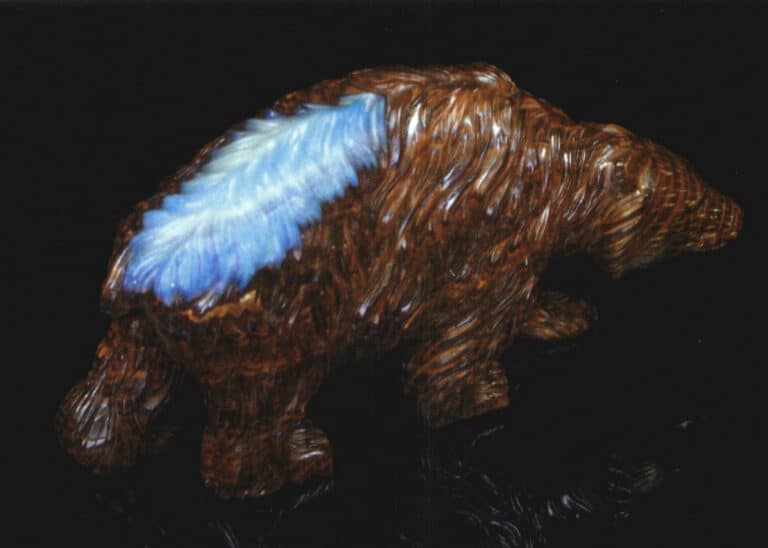
Ukiran Beruang Coklat Opal Australia yang dibeli dari Pameran Perhiasan Hong Kong.
2. Harga Opal Terungkap
Semua jenis di atas sangat berharga, terutama batu opal hitam dari Australia, yang memiliki harga pasar lebih dari US $ $625-938 per karat. Beberapa opal mungkin memiliki lapisan, yang umumnya terlihat sebagai lapisan ganda dan lapisan tiga. Berlapis ganda berarti opal memiliki tiga lapisan di antara batuan induknya, sedangkan lapisan tiga terdiri dari opal, batuan induk, dan kaca. Harga liontin atau cincin opal dengan lapisan di Australia sekitar 100 dolar AS.
Adapun fire opal Ethiopia dan fire opal Meksiko biasanya memiliki berat kurang dari 3 karat, dengan 4 hingga 10 karat dianggap berukuran sedang dan lebih dari 10 karat dianggap sangat besar. Perbedaan harga antara fire opal Ethiopia dan fire opal Meksiko cukup signifikan, dengan harga fire opal Ethiopia sebesar US $ $9-62 per karat, sedangkan fire opal Meksiko berkisar antara US $ $31-312 per karat.
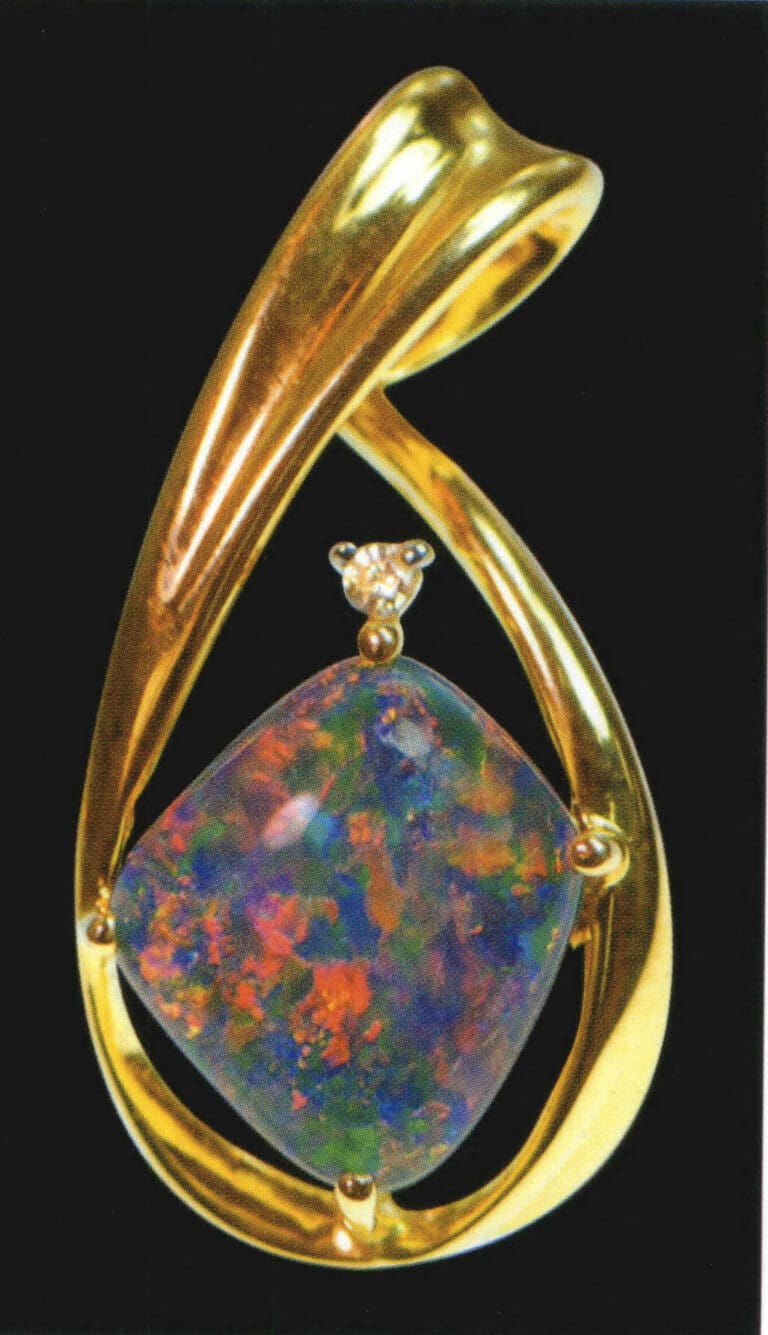
Liontin Opal api Australia, liontin sabun berwarna-warni yang menawan.
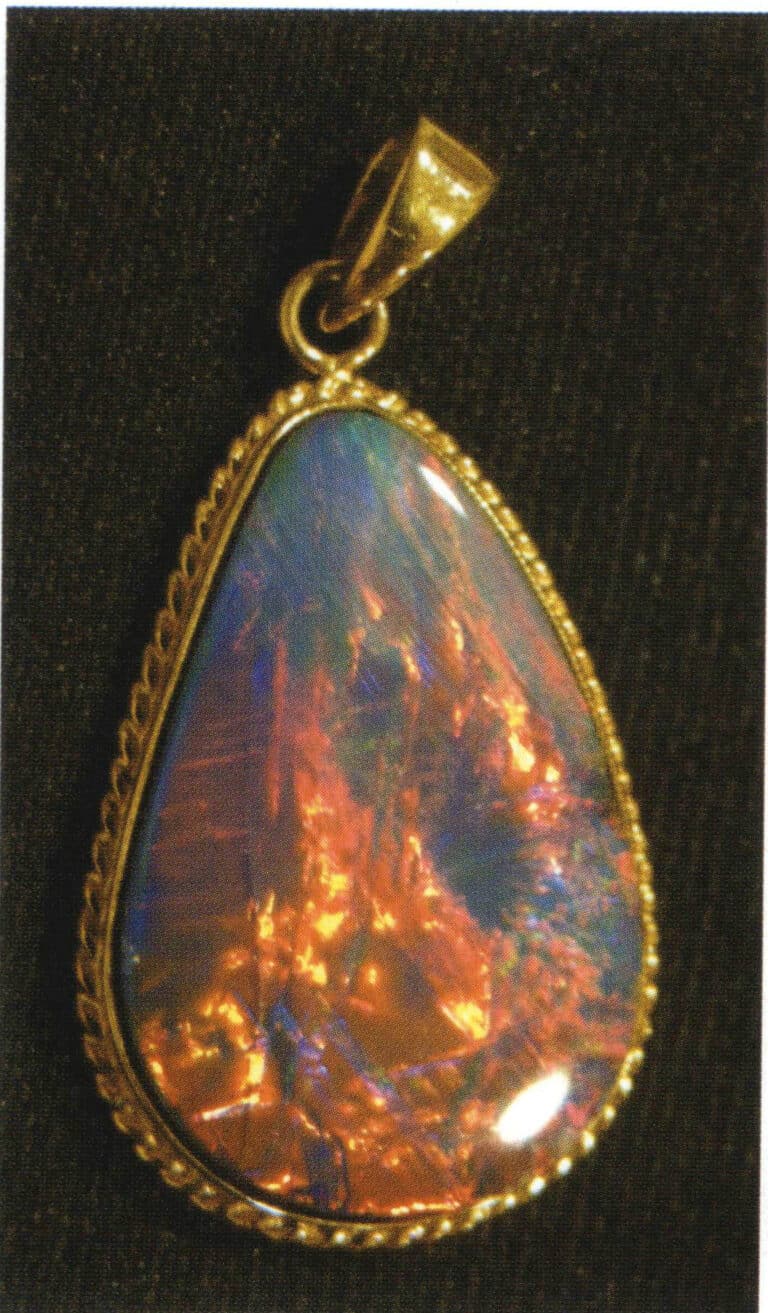
Liontin Opal merah ungu Australia
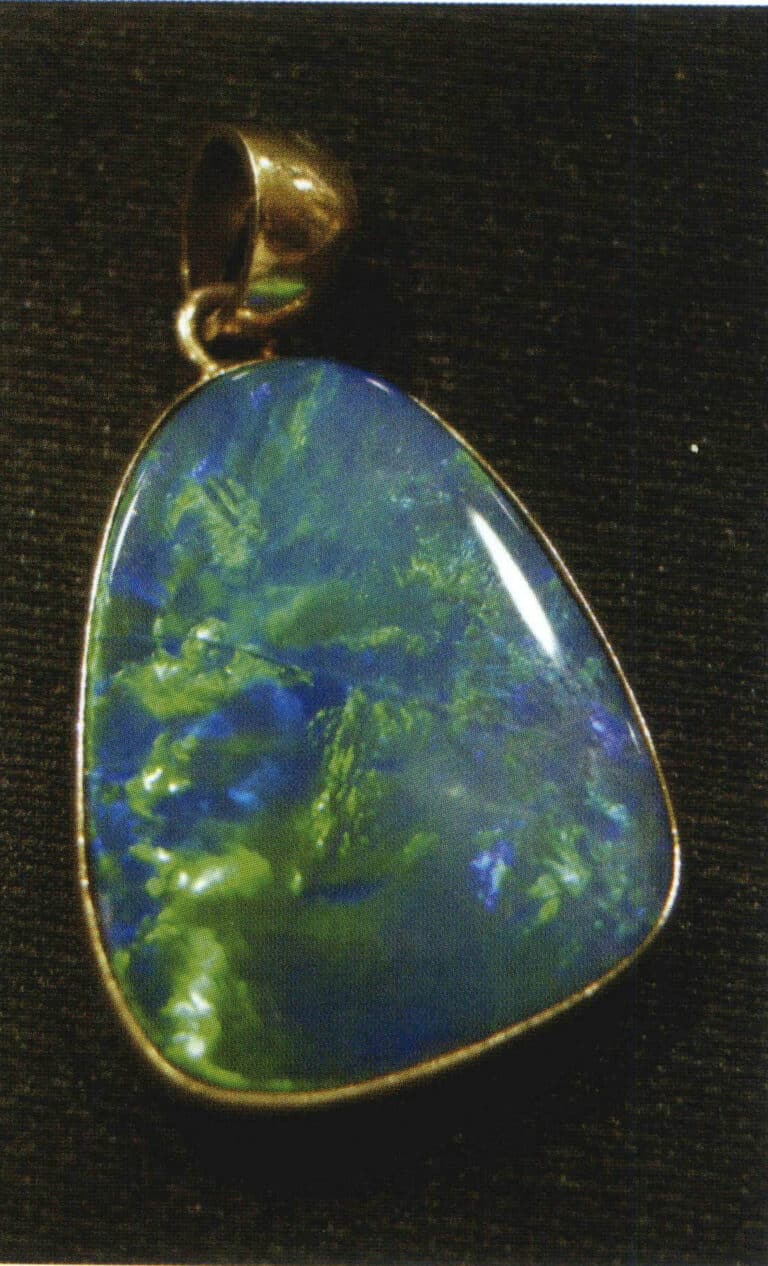
Liontin Opal pirus Australia
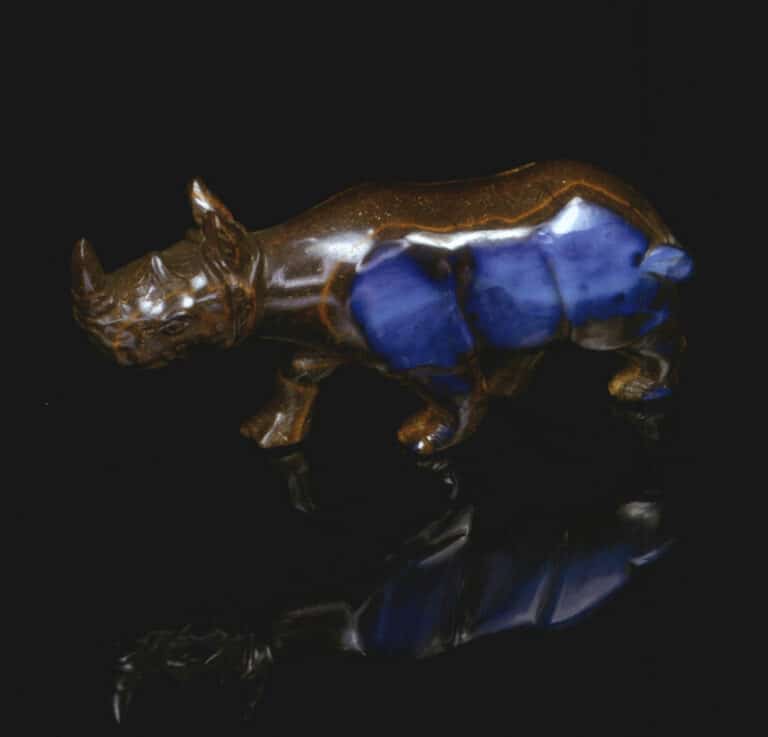
3. Pemeliharaan Opal
Opal memang memesona, tetapi perawatannya penting, karena, seperti mutiara dan amber, opal sangat sensitif terhadap panas dan sinar matahari. Khususnya di bawah cahaya yang kuat, batu ini dapat dengan mudah mengalami dehidrasi; jika dehidrasi terlalu lama, batu ini bisa mengalami keretakan permanen. Oleh karena itu, Anda perlu menyekanya secara teratur dengan air bersih dan menghindari paparan cahaya yang benderang dalam waktu lama. Selain itu, lapisan-lapisannya dapat dengan mudah lepas jika opal berlapis dibiarkan di lingkungan yang kering, atau terpapar panas untuk waktu yang lama.
Ethiopia memiliki tiga area penambangan opal, masing-masing menghasilkan opal dengan karakteristik yang sedikit berbeda. Umumnya, fire opal Ethiopia yang telah dipoles akan mengalami dehidrasi secara bertahap dan berubah menjadi putih di udara (biasanya dalam waktu sepuluh hingga lima belas hari). Jika direndam dalam air bersih selama 10-30 menit, secara perlahan-lahan akan mengembangkan tampilan yang transparan dan berwarna-warni tanpa retak. Oleh karena itu, perawatan rutin harus mencakup perendaman dalam air dan kadang-kadang mengoleskan baby oil untuk mempertahankan kilau warna-warni opal.
Apakah ada opal sintetis?
Ada juga opal buatan. Pada tahun 1974, opal buatan muncul di pasar, diikuti oleh opal hitam. Opal sintetis dan alami memiliki komposisi yang sama dan tidak dapat dibedakan secara kasat mata, dan hanya dapat diamati di bawah mikroskop. Di bawah mikroskop, opal buatan memiliki struktur sarang lebah, kulit ular, atau sisik ikan. Oleh karena itu, ketika membeli opal dari toko perhiasan terkemuka, penting untuk mengetahui asalnya, karena perbedaan harga bisa signifikan berdasarkan sumbernya.
Bagian V Garnet
Umumnya, orang mengira garnet adalah mineral tunggal, tetapi garnet tersusun dari banyak elemen dengan struktur molekul yang sama tetapi komposisi yang berbeda (isomorfisme heterogen). Untuk menentukan komposisi garnet secara akurat, diperlukan instrumen yang rumit dan mahal untuk menyelesaikannya.
| Komposisi | Sistem kristal | Kekerasan | Gravitasi Spesifik | Indeks refraksi | Warna | Pembelahan | Patah tulang |
|---|---|---|---|---|---|---|---|
| A3B2(SiO4)3 A1: Mg, Fe, Mn B1Al A2Ca B2: AI, Fe, Cr | Sistem kristal isometrik | 6.5 ~ 7.5 | 3,5 ~ 4,6 (berubah dengan komposisi) | 1.72 ~ 1.895 | Merah, coklat, kuning dan oranye, Hijau dan hitam | Tidak ada | Seperti cangkang |
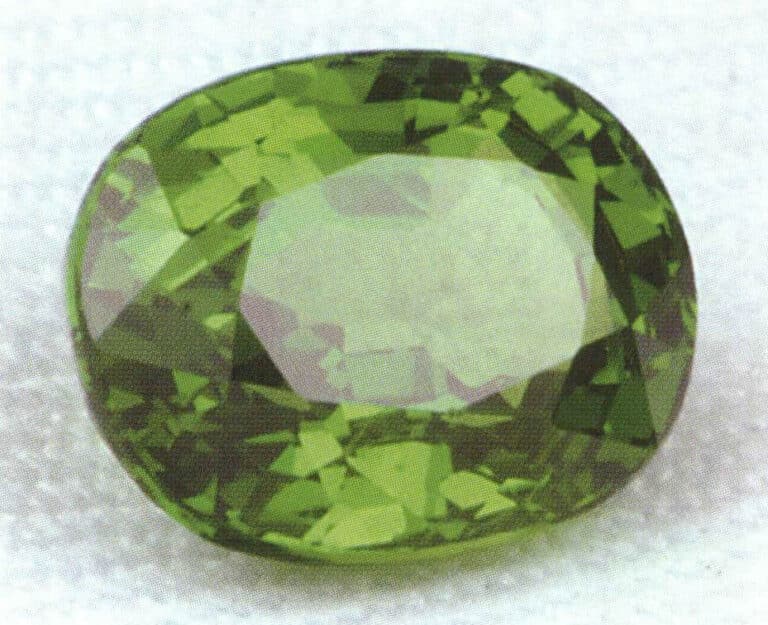
Batu garnet dapat dibagi menjadi dua seri utama berdasarkan komposisi kimianya: Seri Pyrope- Almandite-Pyralspite dan seri Grossularite- Andradite- Ugrandite. Di alam, garnet jarang ditemukan dalam komposisi kimia murni. Berikut ini memperkenalkan dua seri utama garnet.
1. Seri Pyrope- Almandite-Pyralspite
1.1 Tali
Istilah Pyrope berasal dari kata Yunani Pyropos, yang berarti merah seperti api. Pyrope umumnya berwarna merah atau merah mawar. Warna ini memiliki kilau seperti kaca dan transparansi yang bagus. Biasanya, Pyrope memiliki rona merah muda sedikit merah muda, yang cukup populer di kalangan konsumen, dengan ukuran standar sekitar 1-10 karat, dan harga per karatnya tidak jauh berbeda, mulai dari US$9-31
Batu garnet yang mengandung komponen besi-aluminium dan magnesium aluminium disebut Rhodolite. Warnanya lebih ungu dibandingkan dengan Pyrope, dan harganya mirip dengan Pyrope, sehingga populer di kalangan anak muda.
1.2 Almandite
Almandite adalah batu garnet yang paling sering terlihat di kalangan konsumen umum. Almandite berasal dari bahasa Latin Alabandine, dinamai sesuai dengan nama batu delima yang ditemukan oleh filsuf Romawi kuno, Pliny, di Alabanda, Turki. Karena kandungan besinya yang lebih tinggi, Almandite cenderung berwarna merah tua. Ukuran standarnya adalah 1-20 karat. Untuk Almandite di bawah 5 karat, harganya adalah 1 karat US$3-15; untuk ukuran antara 5 hingga 10 karat, harganya adalah US$15-31 per karat; untuk ukuran 10-20 karat, harganya adalah US$46-109 per karat (sekitar 330-770 Yuan Cina). Ini adalah titik masuk yang paling mudah diakses dalam seri ruby dalam hal harga. Saat memilih Almandite, pilihlah yang tidak terlalu gelap; semakin cemerlang apinya, semakin baik.

1.3 Spessartite
Spessartite dinamai sesuai dengan penemuan pertamanya di wilayah Spessart, Jerman. Warnanya berkisar dari kuning-oranye hingga oranye-merah. Spessartite, yang mengandung sedikit Pyrope, ditemukan oleh penjelajah Belanda awal di Afrika dan dihadiahkan kepada keluarga kerajaan; juga dikenal sebagai batu Belanda. Spessartit cukup sulit dibedakan dari topas oranye dan perlu diidentifikasi dengan instrumen. Spessartitet tidaklah murah, dan karena kecemerlangannya, batu ini termasuk jenis yang relatif langka di antara batu permata berwarna oranye-kuning. Ukurannya biasanya sekitar 1-20 karat, dan yang lebih dari 10 karat jarang ditemukan. Umumnya, 1-5 karat Spessartitet berharga US $ $15-93; untuk ukuran 5-10 karat, 1 karat berharga US $ $109-125; untuk lebih dari 10 karat, 1 karat berharga US $ $187-218.
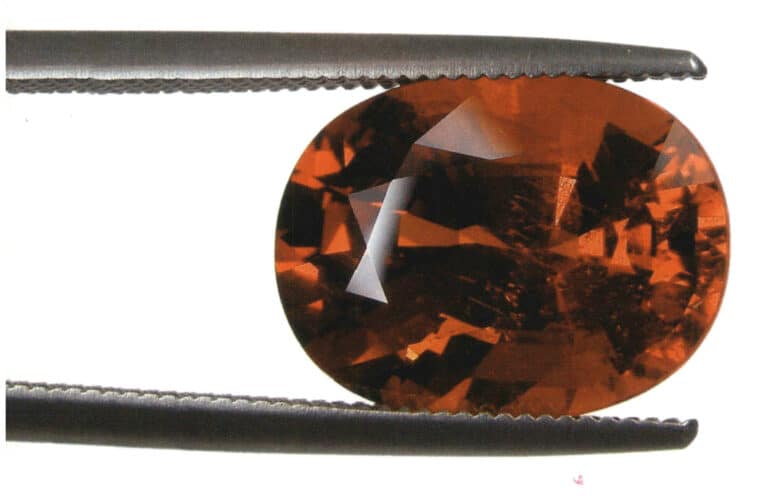
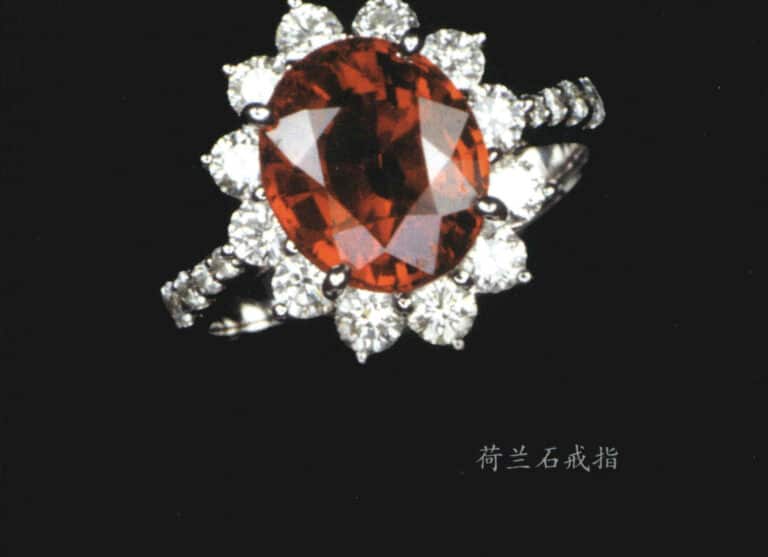
Cincin Spessartite
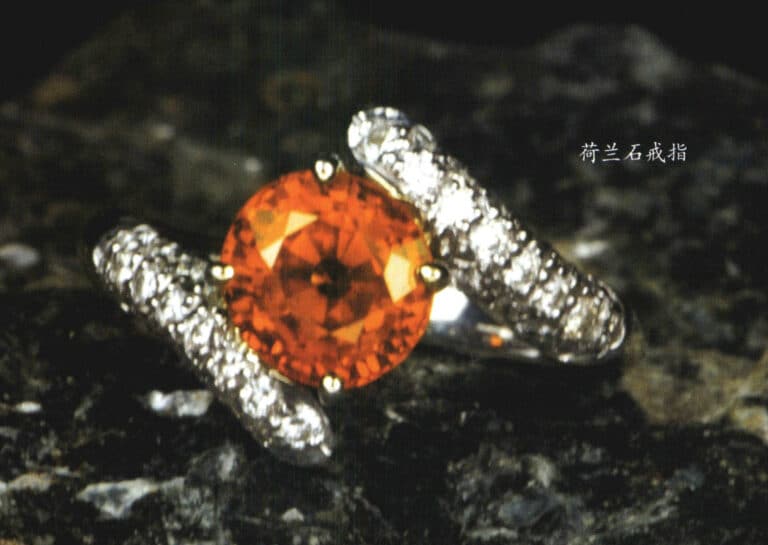
Cincin Spessartite
2. Seri Grossularite, Andradite, Ugrandite
2.1 Grossularite
Grossularite berasal dari kata Latin "menyerupai gooseberry," yang awalnya merujuk pada buah hijau. Karena warnanya yang kaya, bunga ini menjadi populer di kalangan masyarakat. Warnanya berkisar dari kuning kecoklatan, kuning-hijau, dan hijau zamrud hingga hijau tua. Grossularite hijau zamrud, karena adanya kromium atau vanadium, menyerupai zamrud.
Tsavorite
Suatu jenis grossularite juga diterjemahkan sebagai Sphene. Sphene ditemukan pada tahun 1973 di Tsavo, Kenya, dan dinamai sesuai dengan tempat asalnya oleh perusahaan Amerika, Tiffany, pada tahun 1974, yang secara signifikan meningkatkan popularitasnya. Dalam satu hingga dua dekade terakhir, batu ini tetap populer dan berharga. Mengingat harganya yang mahal, mengapa orang menyukai Tsavorite? Pertama, karena kekerasannya mencapai 7,5; kedua, indeks biasnya mirip dengan batu rubi; ketiga, warna hijau gioknya menyenangkan dan terlihat nyaman. Seluruh batu permata akan terlihat cemerlang selama kekerasan dan indeks biasnya tinggi dan potongannya bagus.

2,3 Karat Liontin Sphene
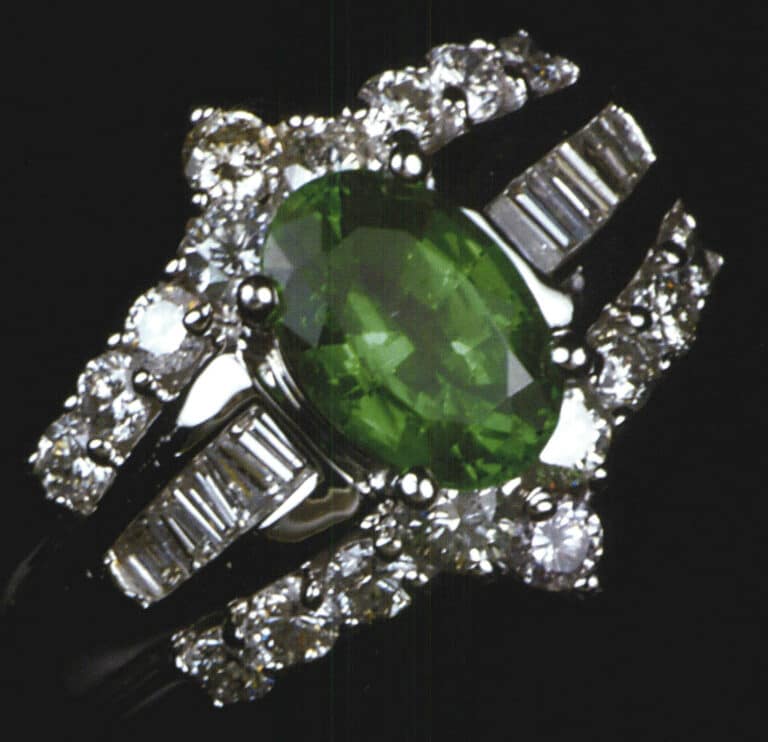
Cincin Sphene
Sphene didominasi warna hijau tua dan sebagian besar diproduksi di Tanzania. Ada yang mengatakan bahwa Sphene adalah "zamrud orang miskin". Terdapat perbedaan harga yang signifikan dibandingkan dengan zamrud berkualitas tinggi, tetapi harga per karat Sphene tidak kalah dengan harga Chrome Verdelite. Harga pasar untuk Sphene 1 karat adalah antara US $ 1.312-469; untuk ukuran 2 karat, harganya US $ 1.625-781 per karat; untuk ukuran 3 karat, harganya US $ 1.94-1.251 per karat; untuk ukuran lebih dari 4 karat, yang berkualitas tinggi sangat langka, dengan harga mencapai US $ 1.653-1.863 per karat. Bagian di atas 5 karat sulit ditemukan, dan harganya bisa dinegosiasikan. Sphenes yang lebih kecil sering digunakan sebagai batu aksen hijau dan cukup banyak dicari di pasaran, tersedia mulai dari 0,8-5 milimeter, tetapi semakin kecil batu aksen, semakin sulit untuk diukir, yang menyebabkan biaya tenaga kerja yang lebih tinggi dan dengan demikian harga yang lebih tinggi. Ukuran umum yang digunakan oleh para desainer adalah sekitar 1-2 milimeter, dengan harga sekitar US$31-62 per karat. Di antara batu permata hijau, selain batu giok, zamrud, dan Sphene, Sphene berada di urutan kedua dalam hal nilai, yang menunjukkan betapa berharganya batu ini.
Hidrogrossular
Hydrogrossular yang tembus cahaya hingga hijau buram, yang disebut oleh para pedagang sebagai "Giok Transvaal", adalah pengganti batu giok dan terkadang keliru diidentifikasi sebagai batu giok oleh para penggemar permata pemula. Hydrogrossular biasanya mengandung inklusi, sehingga sulit untuk menemukan spesimen yang sempurna dan tanpa cacat. Umumnya, ukuran Hydrogrossular berkisar antara 1-5 karat, dengan harga satuan US$25-37.
Hessonite
Grossularite berwarna oranye-coklat disebut Hessonite, yang dapat dengan mudah dikacaukan dengan batu Belanda berwarna oranye-kuning dan membutuhkan instrumen ilmiah untuk membedakannya; perbedaan harga antara keduanya juga signifikan. Hessonite biasanya berkisar antara 1-10 mobil. Hessonite dengan 1-5 karat berharga US $ $9-25; untuk ukuran antara 5 hingga 10 karat, harganya US $ $37-62.
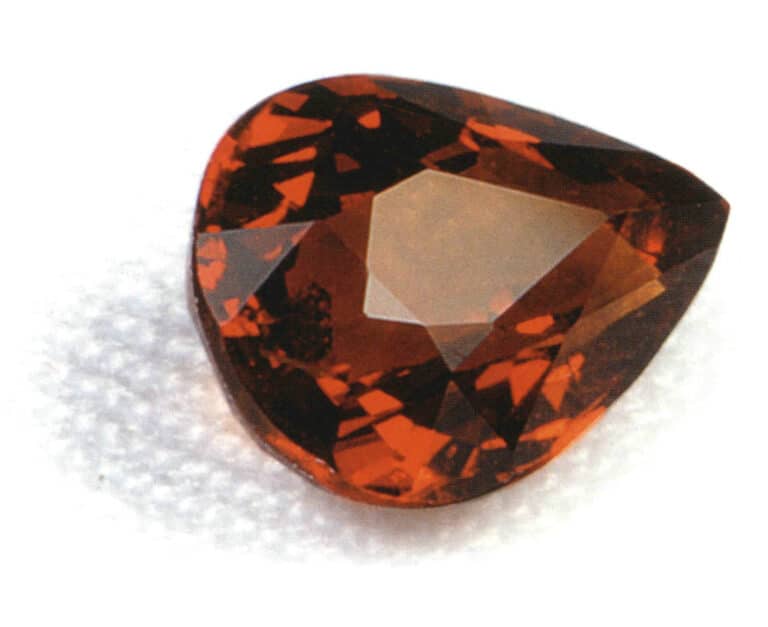
Alexandrite Grossularite
Sejak tahun 2007, Afrika telah memproduksi Alexandrite Grossularite yang bergeser dari biru-hijau ke coklat kemerahan, dengan variasi intensitas perubahan warna. Alexandrite Grossularite 1 karat dihargai US$62-93. Alexandrite Grossularite 2-4 karat cukup langka di pasaran, dengan harga US$156-187; yang lebih dari 5 karat bahkan lebih langka lagi, dengan harga US$312.


Alexandrite Grossularite, yang menunjukkan warna berbeda di bawah cahaya kuning dan putih.
Copywrite @ Sobling.Jewelry - Produsen perhiasan khusus, pabrik perhiasan OEM dan ODM
2.2 Andradit
Andradite dinamai untuk menghormati ahli mineralogi Portugis, J. B. Dandrada Esilva. Warnanya antara lain hitam, kuning-hijau, dan hijau.
Demantoid
Demantoid hijau disebut Demantoid. Karena kelangkaannya, harganya tidak lebih murah daripada zamrud, dan yang lebih besar dari 1 karat sangat langka. Sumber utamanya adalah Pegunungan Ural di Rusia. Warnanya cerah dan menyilaukan, dengan indeks bias dan dispersi yang tinggi. Banyak ahli permata yang ingin mengoleksi batu permata favorit dengan inklusi ekor, tetapi batu ini sudah langka. Di Amerika Serikat, Demantoid 1 karat dihargai $1.000, dan banyak kolektor setia yang masih ingin membeli. Pada pratinjau musim gugur Sotheby's 2010, sebuah Demantoid 7 karat dipamerkan, yang memicu kegilaan penawaran yang sengit di antara para kolektor.
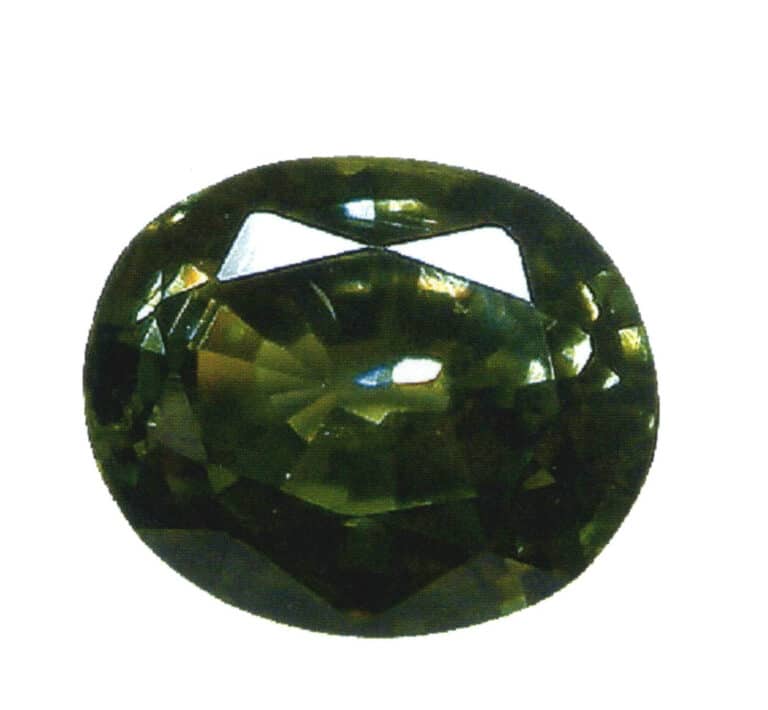
2.3 Uvarovite
Penamaan Uvarovite terutama untuk mengenang presiden Akademi Ilmu Pengetahuan Rusia, Uvarov. Warnanya hijau zamrud, terutama ditemukan dalam serpentinit yang kaya kromium di Pegunungan Ural. Butiran Uvarovite tidak besar, tidak melebihi 2 milimeter, sehingga sulit untuk dipotong, sehingga sangat jarang ditemukan sebagai batu permata di pasaran.
Bagian VI Spinel
Spinel berasal dari kata Latin "Spina," yang berarti duri kecil, terutama mengacu pada ujung runcing kristal. Karena bentuk kristalnya yang tajam, batu ini dinamakan spinel. Spinel adalah batu permata yang sangat mirip dengan batu ruby dan sering ditemukan dalam hubungannya dengan batu tersebut. Di Thailand, para pedagang menyebutnya sebagai "permata lunak" untuk membedakannya dari ruby, yang berarti lebih lembut dalam kekerasan; Pada saat yang sama, spinel mentah dapat dibeli di Myanmar, dengan bentuk kristal yang menyerupai piramida, dan seperti berlian, ia juga berbentuk oktahedral.
| Komposisi | Sistem kristal | Kekerasan | Gravitasi Spesifik | Indeks refraksi | Warna | Pembelahan | Patah tulang |
|---|---|---|---|---|---|---|---|
| MgAl2O4 | Sistem kristal isometrik | 8 | Sekitar 3,58 hingga 3,98 | 1.71 ~ 1.73 | Variabel, menunjukkan warna ungu, biru, hijau, abu-abu, hitam, merah, dan ungu-merah | Tidak berkembang dengan baik | Tidak berkembang dengan baik |

Warna-warna spinel termasuk ungu, merah, kuning, dan hijau rumput, dengan warna merah dan biru-abu-abu yang paling umum. Spinel merah dapat dengan mudah disalahartikan sebagai ruby pada pandangan pertama, menjadikannya target bagi pedagang yang tidak bermoral untuk mengakuinya sebagai ruby, sedangkan spinel biru tidak menyerupai safir karena warnanya yang sedikit abu-abu. Jika spinel merah memiliki warna yang mendekati ruby dan memiliki api yang cemerlang, ukuran 1 karat dapat dijual dengan harga lebih dari US $ $312; namun, jika warnanya tidak semerah itu, spinel 1 karat dapat dibeli dengan harga US $ $15-31. Saat ini, banyak ahli lebih menyukai Alexandrite Spinel, yang bersumber dari Sri Lanka dan tersedia dalam berbagai ukuran yang biasanya berkisar antara 1 hingga 3 karat, dan kualitasnya tergantung pada tingkat perubahan warna dan kebersihannya, sehingga harga spinel yang berkualitas dengan warna yang indah dan sedikit ketidaksempurnaan tidaklah murah. Spinel memiliki inklusi yang jauh lebih sedikit daripada batu rubi, jadi ketika memilih, semakin mirip warnanya dengan batu rubi atau safir, semakin baik.

Sangat penting untuk dicatat bahwa seseorang tidak boleh membeli spinel sintetis. Biasanya, spinel alami mengandung sedikit inklusi spinel oktahedral, yang dapat mengkonfirmasi bahwa itu adalah spinel alami. Cara termudah untuk membedakan antara ruby dan spinel adalah dengan menggunakan mikroskop polarisasi; spinel bersifat isotropis dan tidak terpolarisasi, sedangkan ruby terpolarisasi. Selain itu, spinel kobalt biru sering disintesis dengan metode fusi api di pasaran, yang memiliki garis-garis melengkung dan gelembung-gelembung kecil, yang jelas berbeda dari spinel alami.
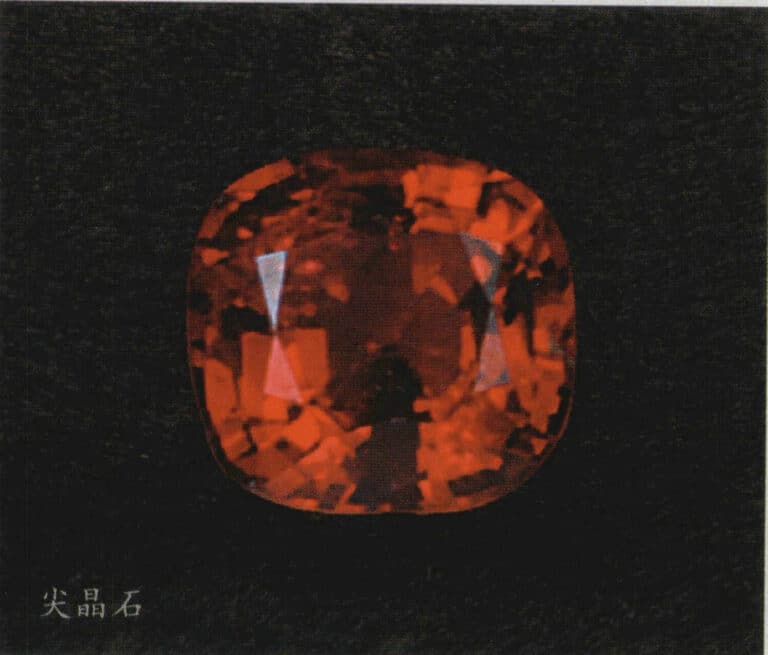
spinel
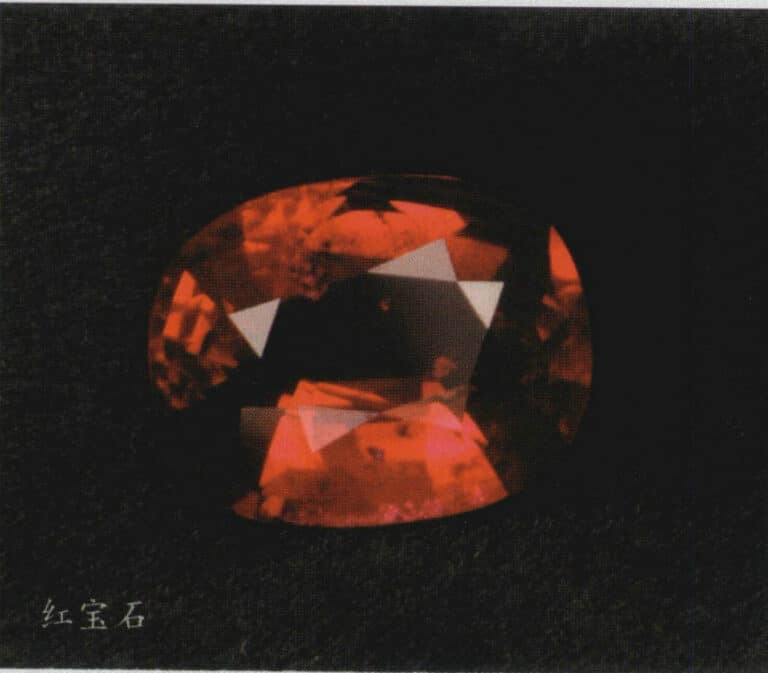
ruby
Spinel Burma dan Ruby Burma memiliki indeks bias yang sangat mirip, sehingga sulit bagi konsumen awam untuk membedakannya. Spektroskop, refraktometer, dan mikroskop polarisasi diperlukan untuk observasi dan diferensiasi.
Bagian VII Mutiara
Kecintaan orang Tionghoa terhadap mutiara tidak kalah dengan kecintaan orang asing terhadap berlian. Jika berlian adalah raja batu permata, maka mutiara adalah ratunya. 30 Tahun yang lalu, di Cina Taiwan, mengenakan kalung mutiara berbudaya Jepang berukuran 7-8,5 milimeter di pesta pernikahan adalah impian bagi banyak pengantin. Saat ini, baik di kalangan bangsawan asing, selebriti, pengusaha, supermodel, atau pekerja kantoran dan pegawai negeri biasa, semua orang mampu membeli untaian mutiara untuk dikenakan (tergantung jenis mutiaranya).
| Komposisi | Sistem kristal | Kekerasan | Gravitasi Spesifik | Indeks refraksi | Warna | Pembelahan | Patah tulang |
|---|---|---|---|---|---|---|---|
| CaCO3 | - | 3 | 2.71 | 1.53 ~ 1.68 | Kuning, putih, merah muda, hitam, abu-abu, biru tembaga | - | - |
1. Jenis-jenis mutiara
Mutiara Air Tawar
Seperti namanya, mutiara air tawar dibudidayakan di danau atau sungai. Area produksi utama adalah danau di dekat Shanghai di Cina, Danau Taihu, daerah Hangzhou, dan tempat-tempat seperti Danau Biwa di Jepang.
Mutiara air tawar memiliki bentuk yang tidak beraturan, menyerupai butiran beras atau telur, dan terkadang tampak datar atau segitiga, dengan mutiara air tawar yang bulat sempurna yang jarang ditemukan. Mutiara air tawar tersedia dalam berbagai warna: putih, putih krem, merah muda, kuning keemasan, dan oranye. Sebagian besar produk jadi dikirim ke Guangzhou dan Shenzhen untuk disortir, dibor, dirangkai menjadi kalung, atau dibuat produk lain. Karena satu kerang dapat memiliki beberapa potong daging yang ditanamkan, hasilnya cukup besar, dan harganya relatif murah. Disarankan untuk memilih mutiara air tawar dengan kilau yang bagus, sedikit noda, dan bentuk yang konsisten. Biasanya, seuntai mutiara air tawar dengan panjang 40 sentimeter dan diameter 5-6 milimeter dapat berkisar dari puluhan hingga ribuan dolar, tergantung pada kebulatan, noda, dan kilau.
Karena harganya yang murah, mutiara air tawar sering diwarnai dengan warna hitam, merah, ungu, biru, hijau, dan warna lainnya, serta dibuat menjadi berbagai macam kalung dan gelang untuk meningkatkan nilai jualnya. Ciri umumnya adalah seluruh untaian memiliki warna yang terlalu konsisten dan seragam, yang terasa terlalu artifisial. Konsumen harus bertanya dengan jelas sebelum membeli untuk menghindari perselisihan
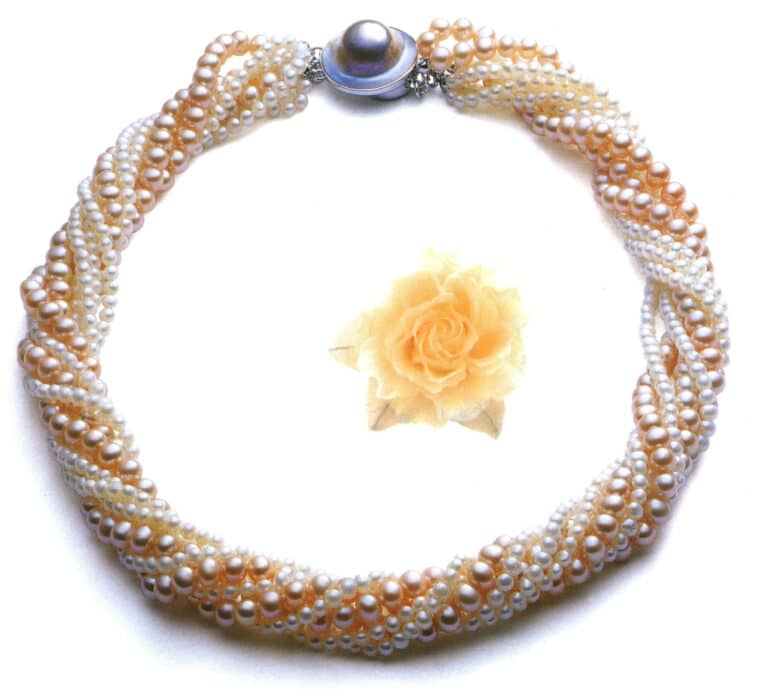
Mutiara Air Asin
Mutiara yang dibudidayakan di laut atau teluk disebut mutiara air laut. Mutiara air laut dibedakan menjadi mutiara Jepang dan mutiara Laut Selatan. Mutiara Jepang adalah salah satu jenis mutiara yang paling disukai, dengan warna merah muda dan putihnya yang menawan menarik banyak konsumen wanita, terutama mutiara Jepang yang berwarna putih dengan sedikit warna merah muda, yang telah menjadi aksesoris terindah bagi banyak pengantin wanita di hari pernikahan mereka. Mutiara Jepang biasanya memiliki diameter tidak lebih dari 10 milimeter. Umumnya, vendor mengklasifikasikannya berdasarkan diameter ke dalam kelas 6-6,5 mm, 6,5-7 mm, 7-7,5 mm, 7,5-8 mm, 8-8,5 mm, dan 8,5-9 mm.
Mutiara dengan diameter kurang dari 7,5 mm cocok untuk konsumen berusia sekitar 20-35 tahun; mutiara dengan diameter 7,5-8,5 mm cocok untuk konsumen berusia 35-50 tahun; mutiara dengan diameter 8,5-9,5 mm cukup langka dan ideal untuk konsumen berusia di atas 50 tahun (tentu saja, ini juga bergantung pada kemampuan ekonomi konsumen). Untaian mutiara budi daya Jepang berukuran 6-6,5 mm, dengan panjang sekitar 40 sentimeter, biasanya memiliki harga pasar US$312-938. Sedangkan untuk mutiara budi daya Jepang berukuran 8,5-9 mm, karena kelangkaannya, harga pasarannya bisa mencapai US$2501-3127, tergantung pada kilau, cacat, dan warnanya.
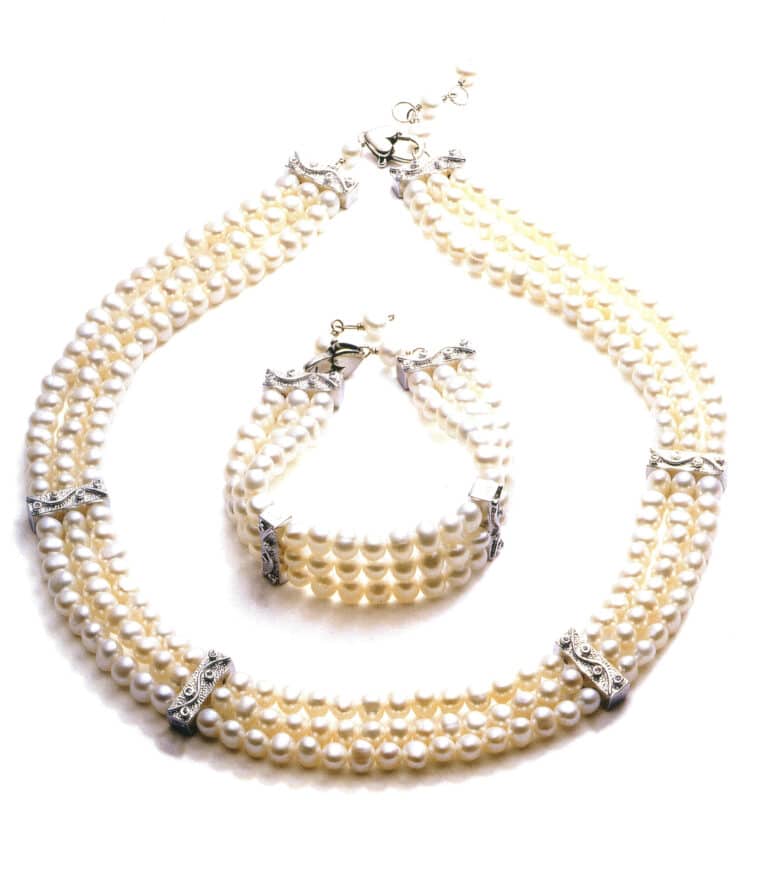
Mutiara Laut Selatan
Mutiara Laut Selatan sebagian besar diproduksi di wilayah Pasifik Selatan, termasuk perairan Myanmar, Filipina, Indonesia, Thailand, Australia, dan negara-negara lainnya. Sebagian besar mutiara Laut Selatan dibudidayakan dari tiram berbibir emas atau berbibir perak, yang memiliki diameter sekitar 30 cm, kira-kira seukuran tangan, menjadikannya jenis tiram terbesar. Mutiara yang dihasilkan dapat berkisar dari diameter 9-18 mm. Waktu budidaya secara umum adalah 1,5-2 tahun, lebih pendek dari mutiara hasil budidaya Jepang (2-3 tahun), dengan ketebalan sekitar 1 mm.
Warna mutiara Laut Selatan biasanya berwarna putih keperakan, merah muda, kuning, dan kuning keemasan, dengan warna merah muda yang paling banyak digemari orang. Mutiara Laut Selatan memiliki kinerja penjualan yang baik di Cina dalam dekade terakhir.
Bentuk mutiara Laut Selatan sebagian besar tidak beraturan; berikutnya adalah bentuk bulat; bentuk tetesan air mata atau buah pir lebih baik, paling cocok untuk membuat liontin atau anting-anting; yang paling tidak umum adalah bentuk semi oval dan bulat. Mengambil contoh mutiara bulat sempurna dengan diameter 14 mm dan kilau merah muda, harga pasarannya sekitar US $ 1.025.000; jika berbentuk oval, harga pasarannya US $ 1.312.000. Ukuran, jumlah, dan distribusi tonjolan atau cekungan di permukaan mutiara juga merupakan faktor penting yang mempengaruhi harga. Jika mutiara Laut Selatan memiliki kilau kekuningan, harganya relatif lebih rendah, tetapi mutiara kuning keemasan sangat berharga. Kalung mutiara emas alami, jika memiliki diameter 14-15 mm, harganya bisa mencapai lebih dari US $ $31341; Anda harus sangat berhati-hati saat membeli untuk menghindari membeli mutiara emas yang diwarnai. Jika seutas kalung mutiara emas dijual seharga US$4701-6268, harganya terlalu murah, jadi Anda harus memberi perhatian khusus apakah itu mutiara emas yang diwarnai.
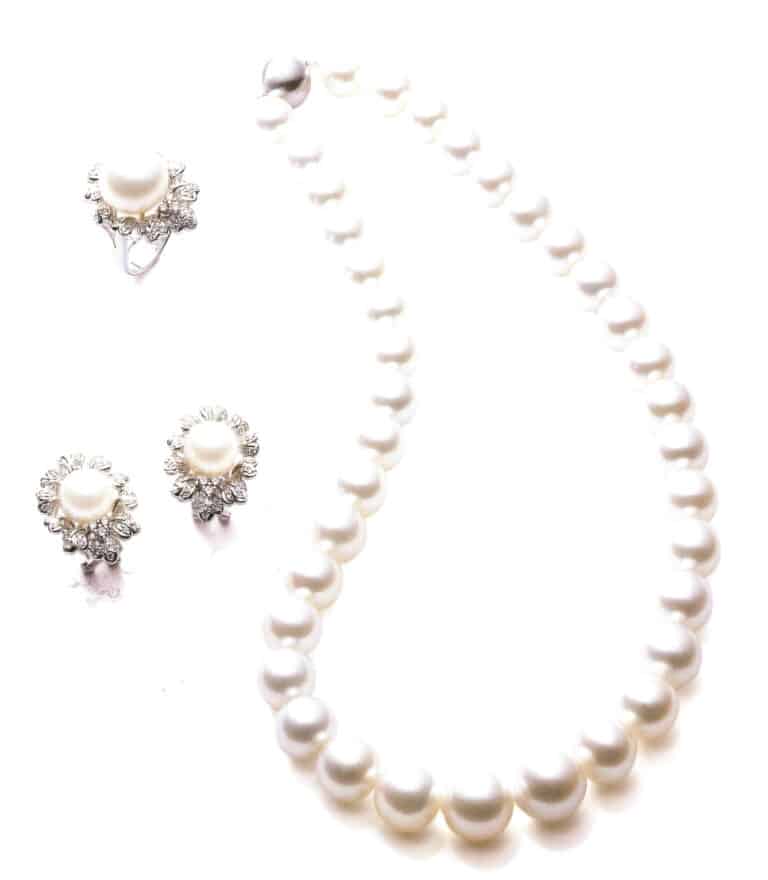
South sea white pearls jewelry set including necklace and ring, earring.
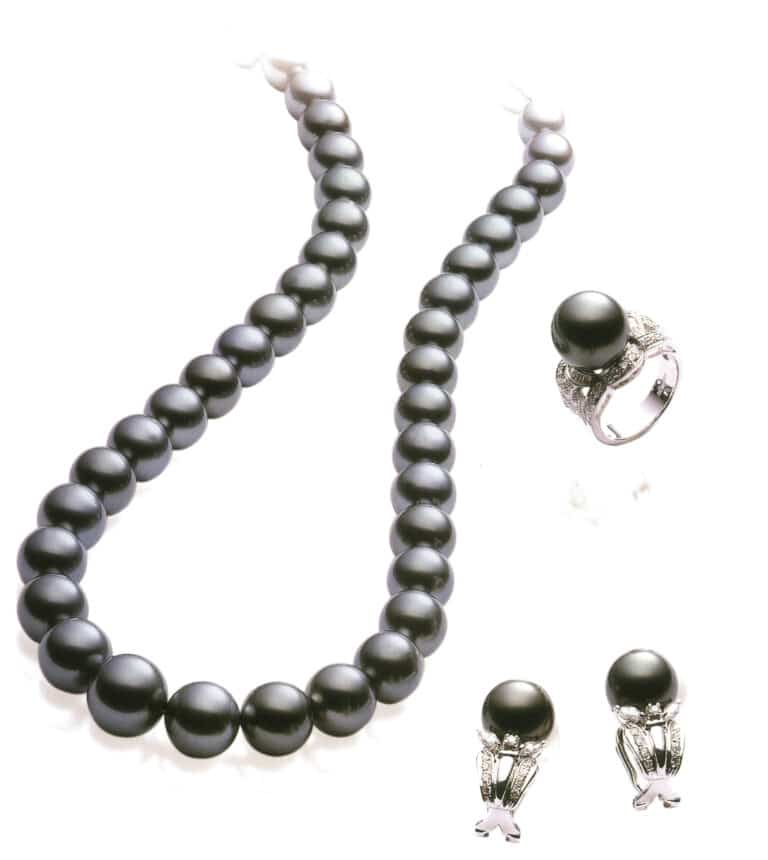
Tahitian peacock green black pearls Jewelry set including necklace and ring, earring
Black pearl
The islands of French Polynesia, particularly Tahiti, are famous for producing large, high-quality black pearls. In addition, small quantities of black pearls are made in the Philippines and Okinawa. The average size of Tahitian black pearls is 8-11 mm, and a diameter of 12-14 mm is considered quite large. Occasionally, a black pearl with a diameter of 18 mm is found, which is truly a gift from God!
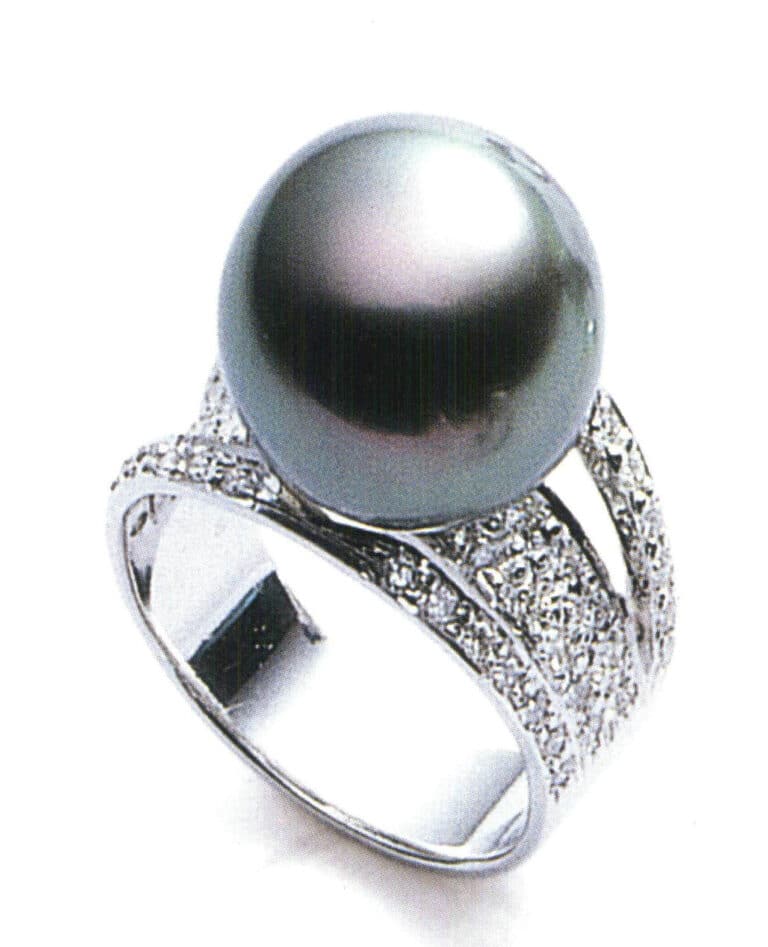
Black Pearl Ring
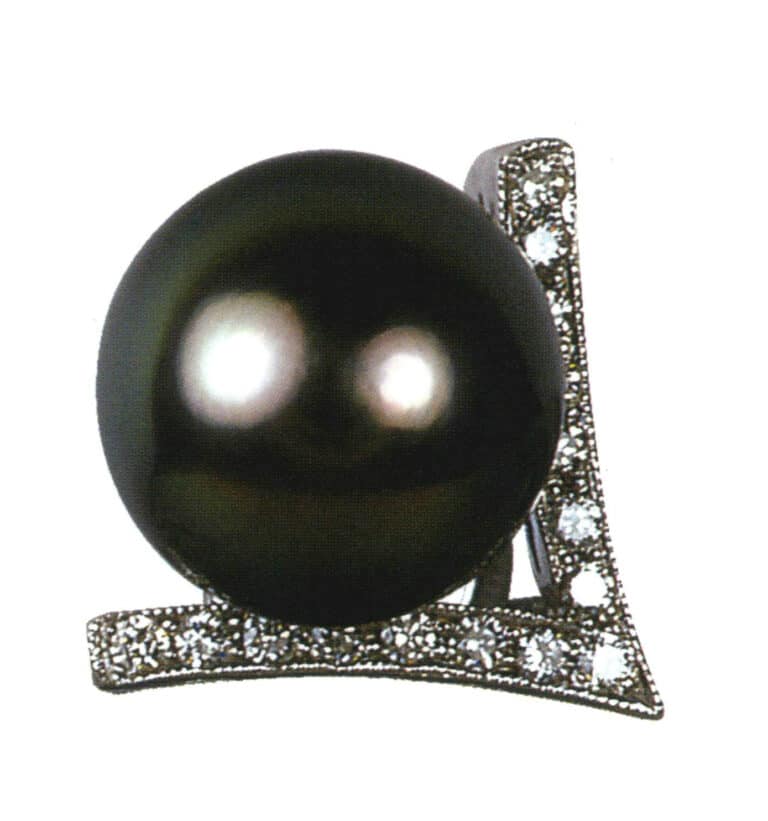
Peacock Green Black Pearl Ball
The shape of black pearls can generally be divided into spherical, pear-shaped, irregular, and button shapes. The highest grade is the spherical shape, which also has the highest price. Of course, luster, color, and degree of blemishes will also affect the cost. The luster of black pearls is different from that of white pearls; if the luster of white pearls is good enough, they appear more gentle, while if the luster of black pearls is good enough, it resembles a bright mirror. Black mop produced by black-lipped oysters can be black, gray, green, blue, and coffee colors. The darker the body color of the black pearl, the higher its value. Recently, the most sought-after in the market is a type of green pearl based on black, also known as peacock green, which has the highest price and is the most popular in the black pearl market.
2. How to choose pearls?
Pricing of pearls
The selection of pearls prioritizes color and luster, blemishes, and shape. Even irregular pearls can be transformed into beloved little accessories with the designer’s ingenuity. They still have their selling points as long as the color is beautiful and the surface is smooth. Prices are usually determined by diameter; the rounder they are, they become more expensive.
The combination of skin tone and pearl color
You should place pearls on your skin, especially your neck, to see if the pearl colors match your skin tone. Women with fair skin can boldly try black, yellow, and pink pearls; women with darker skin should choose white or pink pearls. Pearls and clothes color matching, still with black pearls with light-colored clothes, contrast, the most conspicuous. Additionally, silk fabrics can prevent pearls from being scratched and can better highlight the softness of the pearls.
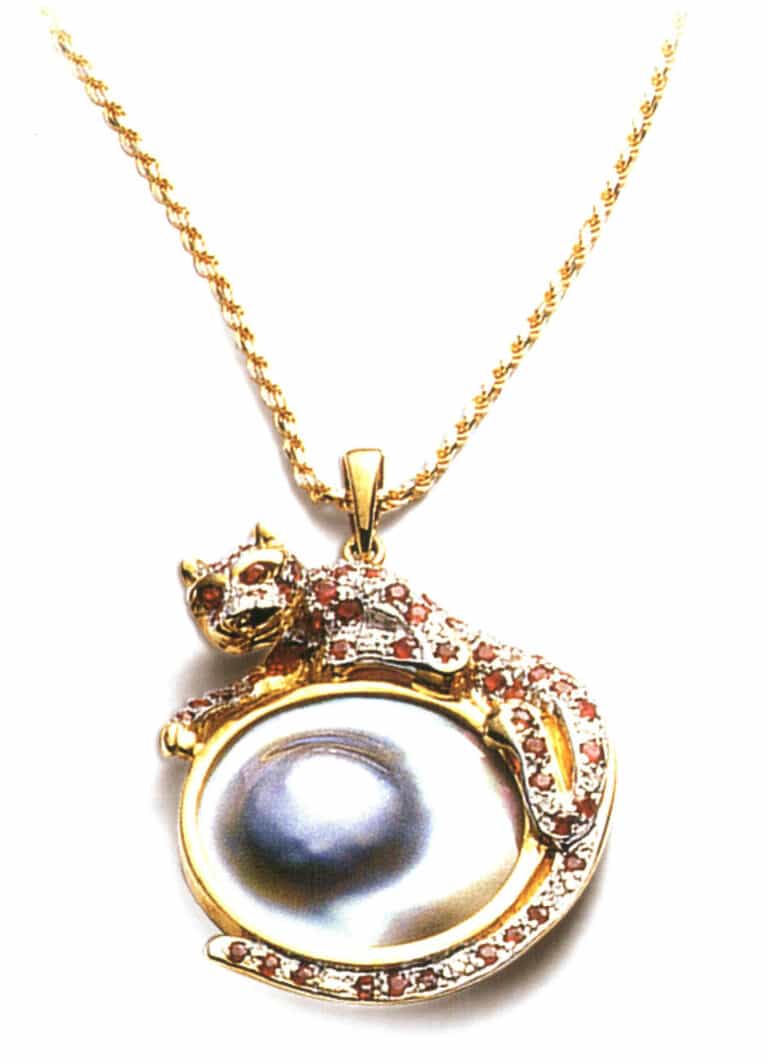
How to choose a pearl necklace
Choosing a pearl necklace is a significant study; besides considering your body shape and the thickness ratio of your neck, it is also closely related to the style of your clothing neckline. Short necklaces are suitable for V-neck tops; princess-length ( 40-50 cm) pearl chains can be worn with pendants and look good with round-neck shirts; wearing multiple strands of pearls layered is currently the most popular way to wear freshwater pearls; two short chains are suitable for pairing with boat-neck dresses.
How to choose a pearl Ring
Wearing rings with horizontal lines, multi-layered settings, and round and square gemstones is very suitable for long fingers. For friends with short fingers, choosing pear-shaped, oval-shaped, or straight-line bracelets is advisable, as they can make the fingers appear longer.
3. Genuine pearls or fake pearls, just bite, and you will know.
The method passed down by the older generation for identifying pearls is to bite them. That’s right! Both cultured and natural pearls will have a rough feeling like sand, while plastic pearls will feel smooth. However, this method can only be tested at home behind closed doors; generally, merchants will not allow consumers to do this test in the store, not to mention what if you bite and damage it. I also do not entirely agree with this. Some gem books suggest using specific gravity liquid to measure density and using a refractometer to test pearls. I disagree with either because these liquids can cause a lot of damage to the pearls. Additionally, wiping the surface of pearls with alcohol or acetone can dissolve the dye, but this method will also damage the pearls and is not worth trying.
The best way to distinguish between real and fake pearls is to use a high-powered magnifying glass or microscope to observe the surface of the pearl. Under a 50-60-fold microscope, it is easy to see the seams, pits, or bumps on the surface of the pearl; fake pearls, on the other hand, have a relatively smooth surface. Additionally, imitation pearls may show signs of skin peeling at the drilled holes.
In addition to plastic and glass imitation pearls, dyed pearls and those that change color due to radiation exposure have flooded the pearl market in recent years. Dyed black pearls are made by soaking white pearls in silver nitrate to turn them black. To identify them, you can use a magnifying glass to check if the color appears dull and if the color is more profound in the cracks; furthermore, a relatively new identification method involves using a Chroma filter to observe dyed black pearls and those that change color due to radiation. Under light, the color appears dark red, while natural and cultured pearls do not change color under the filter. If the pearls are strung together, you can check if the thread color matches the pearls to make a judgment.
A type of shell pearl on the market is made by grinding shells into beads and then coating the surface with color. A necklace of shell pearls with a diameter of 9 mm can sell because all these liquids can cause a lot of damage to the pearls. US$125-156in department stores, while at the Jade Market, it can be bought for only US$15-47. The way to identify them is that each bead is almost identical, flawless, with a smooth surface, and the luster is not as natural as that of cultured pearls.
4. How to care for pearls?
When it comes to pearl care, readers must first understand its composition and physical properties. The mineral composition of pearls is mainly aragonite and calcite. Generally, aragonite is more prevalent, and both mineral components are calcium carbonate (CaCO3). Still, aragonite has a specific gravity of 2.93- 2.95 and a hardness of 3.5-4.0 , while calcite has a specific gravity of 2.71 and hardness of 3. When fresh pearls gradually lose moisture under heat and fire, they transform from aragonite to calcite, known as “the aging of pearls.” With this knowledge, one will have a basic concept of pearl care. Jewelry stores typically teach consumers to clean pearls with tap water, which is a very mistaken notion. The pH value of tap water is generally around 4, and when it is less than 7.8, calcium carbonate will dissolve, corroding the pearls.
It is recommended to wipe and clean with water at a pH value of 8.0-8.5 or use distilled water to prevent the aging of pearls. Additionally, pearls should avoid direct contact with the skin; they can be isolated with clothing or a ring holder to prevent sweat erosion. After using perfume or hair gel, please avoid direct contact with these before wearing them. In overheated places like a sauna, pearls should be worn as little as possible. Wear soft silk clothing to reduce the chance of scratching the pearls. The climate in China Taiwan is quite hot, so wearing a pearl necklace requires maintenance every night, just like taking care of your own skin; this way, the pearls will remain as good as new.
5. Can eating pearl powder make the skin whiter?
I am often asked this question, which makes me curious as well, so I investigated the situation of consuming pearl powder in a community. Among the 35 people, 26 were female, and 6 had taken pearl powder during pregnancy. As for whether it had a noticeable effect on the baby’s skin, they had different opinions. One People took it during her first pregnancy but not during her second, and as a result, the first child had whiter and more elastic skin than the second. Other students felt they couldn’t notice any effect because pearl powder was too expensive, and they didn’t take much of it.
I am not a doctor and cannot make any recommendations, but it is true that consuming too much of anything can put some burden on the body. Therefore, it is essential to follow the doctor’s instructions when taking it, pay attention to the dosage, and be careful not to consume counterfeit products (powder made from shells).
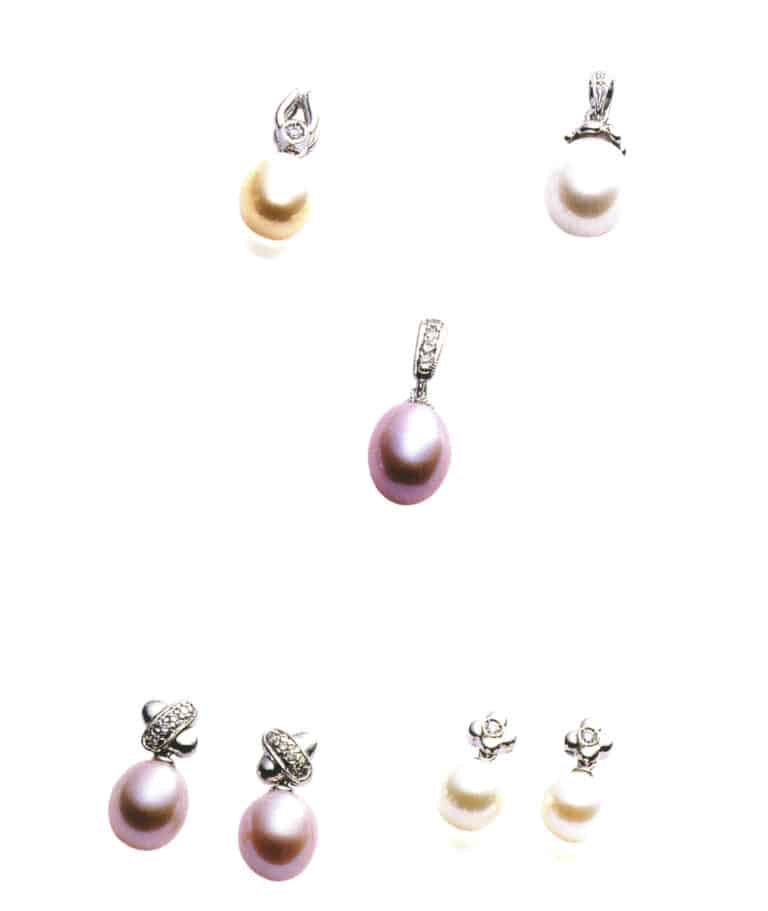
Section VIII Feldspar
Feldspar is one of the most common minerals on Earth. The feldspar family has a wide variety, with common gemstones including moonstone, sunstone, Labradorite, and amazonite.
1. Moon Stone
The composition of moonstone is a semi-transparent Labradorite, named for its appearance that emits a light similar to moonlight. Moonstone sometimes exhibits white light, pale blue sheen, cat’s eye (containing needle-like inclusions), and starstone phenomena.
| Komposisi | Sistem kristal | Kekerasan | Gravitasi Spesifik | Indeks refraksi | Warna | Pembelahan | Patah tulang |
|---|---|---|---|---|---|---|---|
| KalSi3O8 | monoclinic crystal system | 6 | 2.57 | 1.52 ~ 1.53 | 1.52-1.53 Colorless, gray, white, flesh red, black, orange predominates | Complete (often fuzzy) | Uneven to shell-like |
How to choose Moonstone
Moonstone has been shining in the market in recent years due to the promotion by the international silver jewelry brand George: Jason. After George. Jason launched the Moonlight series; there has been great interest in this gem that emits a bright moonlight from the fashion industry, designers, and general consumers alike.
The cleavage of moonstone is well-developed, with a texture that is as transparent as glass, subtly emitting a blue light. The price varies depending on color and texture, with the most expensive being the transparent, glass-like blue moonstone resembling deep sea blue, followed by semi-transparent and opaque blue moonstone. The cheapest is the opaque moonstone. Opaque moonstone comes in colors such as black, gray, silver-gray, pink-orange, and orange, with varying prices. It is not expensive, priced at US$0.7-1.5 per carat, making it ideal for friends new to metalworking to practice their creations.

The top-grade transparent blue moonstone, which is as clear as glass, is priced based on its clarity and the intensity of its blue color. Those over 10 carats are relatively rare, with a market price of US$ 62-94 per carat; for moonstones sized between 5 to 10 carats, the price is US$ 25-37 per carat; and for those sized between 1 to 5 carats, it is US$ 12-25 per carat. If the moonstone has internal cracks, the price can vary significantly; sometimes, semi-transparent blue moonstones with cracks, weighing over ten carats, can be found for only US$ 15-31.
2. Sun Stone (Oligoclase)
Sunstone, solar stone, or sunlight stone primarily comprises oligoclase. The crystals often contain slight inclusions of needle-like iron ore, biotite, and hematite, which reflect a dazzling golden-yellow light, giving it its name.
| Komposisi | Sistem kristal | Kekerasan | Gravitasi Spesifik | Indeks refraksi | Warna | Pembelahan | Patah tulang |
|---|---|---|---|---|---|---|---|
| (Na,Ca)Al1-2Si2-3O8 | Triclinic crystal system | 6 ~ 6.5 | 2.62- ~ .65 | about 1.54 | Golden, reddish brown. glittering | Completely | uneven to shell-like |
Sunstone Selection
Sunstone can be purchased at online auctions or the Jade Market. 1-carat costs between US$3-6, considered a very affordable gemstone and a favorite among many friends in the silver and gold industry. Many young sellers create products featuring sunstones to highlight their design styles and auction them online, achieving good sales performance. Sunstone often has stone patterns; choose those that are not on the surface.

3. Labradorite
Labradorite is named after its discovery in Labrador, Canada. It is semi-transparent and exhibits green, blue, yellow, purple, and golden-red colors. The play of colors is mainly due to Labradorite’s parallel twin crystal planes, which create interference patterns when light hits different planes.
The Labradorite produced in Finland is also known as Spectrolite, just like a prism that separates the sunlight spectrum into a rainbow. The Labradorite from Utah, USA, is a slightly yellowish transparent variety; the Labradorite from Canada is found on the coast of Labrador; hence, it is also called “Labradorite.”
| Komposisi | Sistem kristal | Kekerasan | Gravitasi Spesifik | Indeks refraksi | Warna | Pembelahan | Patah tulang |
|---|---|---|---|---|---|---|---|
| (Na,Ca)Al1-2Si2-3O8 | Triclinic system | 6 ~ 6.5 | 2.7 | 1.559 ~ 1.568 | Colorless, yellow, brown, light to dark gray | Complete | Uneven to flaky |
How to buy Labradorite
Spectrolite is relatively inexpensive, and most of it is made into silver jewelry items. Finished products can be bought for just a few dozen dollars at jade markets or online auctions, with a maximum of over US$31. Clean specimens of Spectrolite are rare; pay attention to its rainbow colors. Spectrolite rough stones and raw materials can be found in online auctions or jade markets for 1 carat at US$06-0.9, making it a favorite among beginner metalworking students.
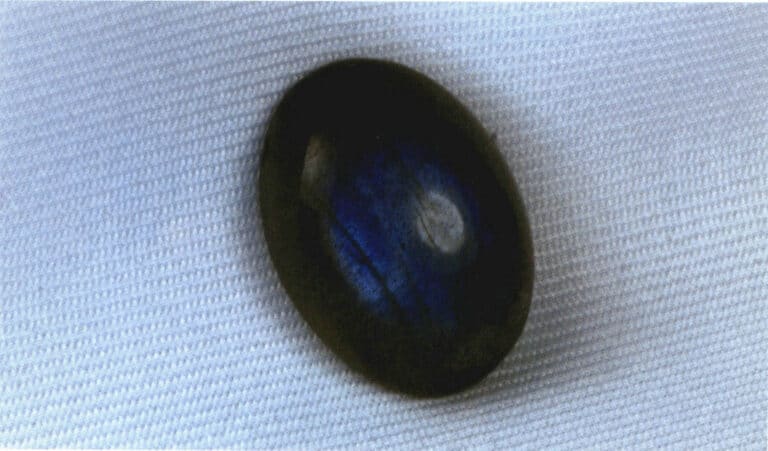
4. Amazonite
Amazonite, also known as Amazonite, is primarily composed of microcline and is sky blue or green. It features cross-shaped net-like stripes and is usually opaque. Some merchants may use Amazonite as a substitute for jade, with the main difference being their specific gravity.
| Komposisi | Sistem kristal | Kekerasan | Gravitasi Spesifik | Indeks refraksi | Warna | Pembelahan | Patah tulang |
|---|---|---|---|---|---|---|---|
| KalSi3O8 | Triclinic crystal system | 6 ~ 6.5 | 2.56 ~ 2.62 | 1.518 ~ 1.527 | light yellow | Complete | Uneven to lobed |
Selection of Amazonite
Amazonite products are not commonly seen on the market, mostly sold as raw stones, with prices ranging from tens to hundreds of dollars depending on size.
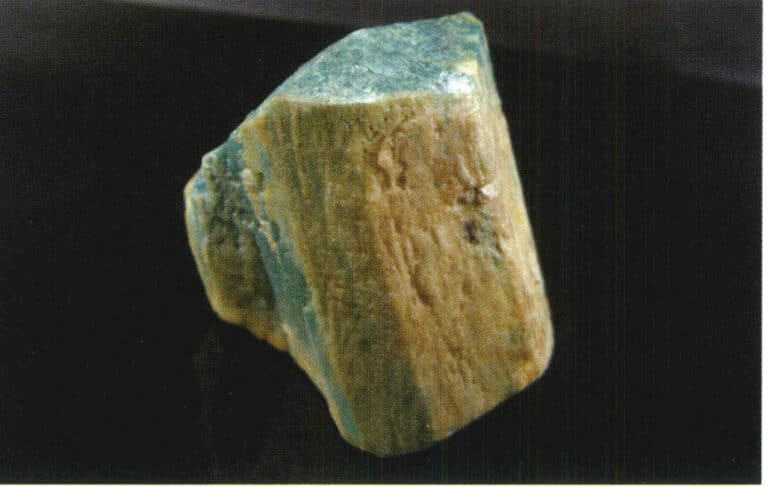
5. Andesine
Neutral feldspar, also known as andesine, has appeared in large quantities in the international market since 1997, attracting attention to this emerging gemstone. The primary colors are red and orange, produced in the United States, Africa, and China. It contains many needle-like inclusions, and the uniformly colored neutral feldspar looks like ruby, selling for 40-50 dollars per carat on the market.
| Komposisi | Sistem kristal | Kekerasan | Gravitasi Spesifik | Indeks refraksi | Warna | Pembelahan | Patah tulang |
|---|---|---|---|---|---|---|---|
| (Na, Ca) Al1-2Si2-3O8 | Monoclinic system | 6 | 2.57 | 1.52 ~ 1.53 | Red, orange | Complete (often vague) | Berbentuk cangkang |

Section IX Amber
Like pearls and coral, Amber is an organic gemstone that consumers love for its beautiful color and soft texture. Amber is a fossilized tree resin from 30 to 60 million years ago and is classified as an organic material. Its main component is resin, and it has a very low hardness. During its formation, Amber often encapsulates insects, with flies, ants, and ant-like creatures being the most common, while those containing scorpions are the rarest and most valuable; the more insects it contains, the more useful it is. It is mainly produced in the Baltic Sea, China, Italy, Romania, and Myanmar. In Dominican amber, approximately one out of every hundred raw stones contains insect inclusions; in Baltic amber, only one of every thousand includes insects.
| Komposisi | Sistem kristal | Kekerasan | Gravitasi Spesifik | Indeks refraksi | Warna | Pembelahan | Patah tulang |
|---|---|---|---|---|---|---|---|
| - | Amorphous | About 2 to 3 | 1.05 ~ 1.12 | About 1.54 | The male has opaque wax in yellow and colors like blue and green. | - | - |
Besides being made into ornaments, Amber is also a type of traditional Chinese medicine that can be purchased in Chinese medicine shops. Unprocessed Amber has a resinous luster, and after polishing, it presents a resinous luster close to glass luster. Generally, it is distinguished by color: opaque waxy yellow is called beeswax, golden yellow is called golden Amber, red is called crimson amber, blue is called blue Amber, and opaque black is called black Amber. Suppose the light can be seen under the transparent red called orange color amber. Blue Amber is relatively precious and will exhibit blue fluorescence under fluorescent light.
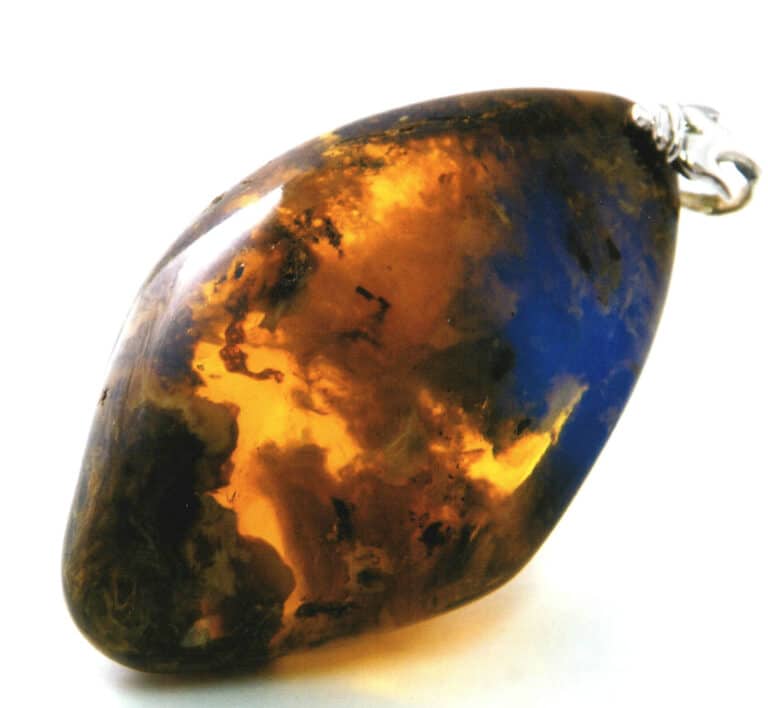
Blue Amber Pendant

Amber Gourd
1. How do we distinguish between genuine and fake Amber?
Natural Amber is becoming rare, so recycled Amber, mixed Amber (real amber combined with chemical components), and fake Amber have become prevalent.
Commonly seen recycled Amber on the market is made by heating amber fragments until they melt and then reshaping them. During manufacturing, the producers creatively add insects, flower petals, and more. How can you distinguish between real and fake? It depends on the degree of struggle of the insects in the Amber. Generally, the wings and limbs of insects in recycled Amber appear stiff. If the insect struggles and dies in the resin, its body and legs will be separated, and the wings will be spread out, showing an attempt to escape. Additionally, There are tiny air bubbles in Amber because insects exhale their last breath when they finally die in the resin. It is also because when recycled Amber cools, the uneven internal heat dissipation produces record-like oval flakes (commonly known as sunflowers), which is the best way to recognize recycled Amber.
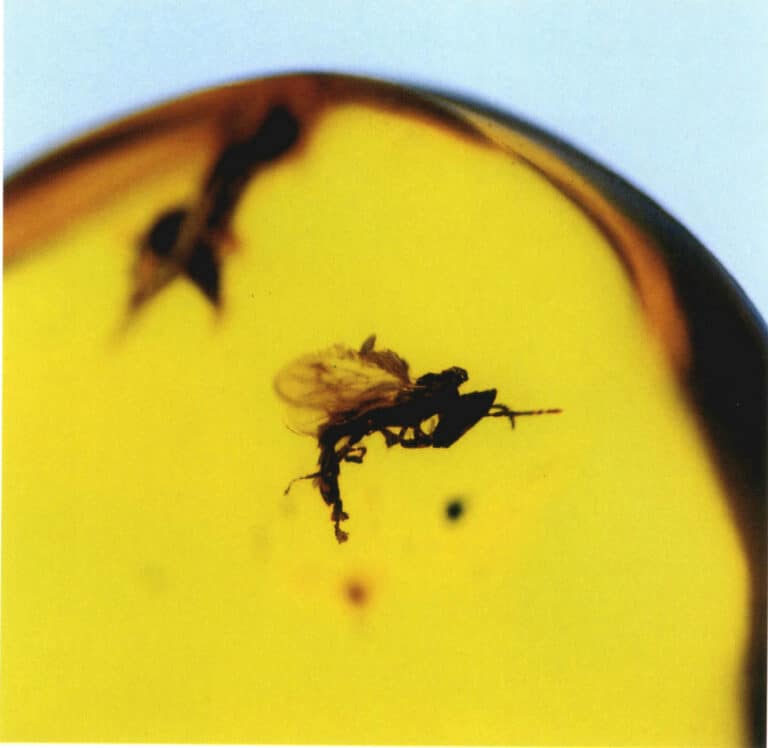
Additionally, because recycled Amber cools unevenly, it can produce oval-shaped objects similar to records (commonly referred to as sunflowers), which is also the best method to identify recycled Amber. Moreover, there is a simple method: place the Amber in saturated saltwater (add salt to the water and stir until the salt can no longer dissolve). If it sinks, it is fake because it is heavier. However, if it floats, it is not necessarily real; it could be a counterfeit specially adjusted for weight. This method can only confirm that the one that sinks is fake. If the Amber has various colorful swirls (commonly red, green, and purple), it indicates that it is artificially made.
2. Market information revealed
Amber is commonly made into bracelets, prayer beads, necklaces, etc., generally priced by the gram, with 1 gram usually costing US$9-15; a bracelet costs around US$31-125; a necklace can range from a few thousand to US$312-624; the most expensive and rarest blue Amber is priced at 1 gram for US$15-46. Fake Amber (plastic beads) can be bought for a bracelet at US$9-15. Consumers can compare prices to find affordable and desirable Amber.
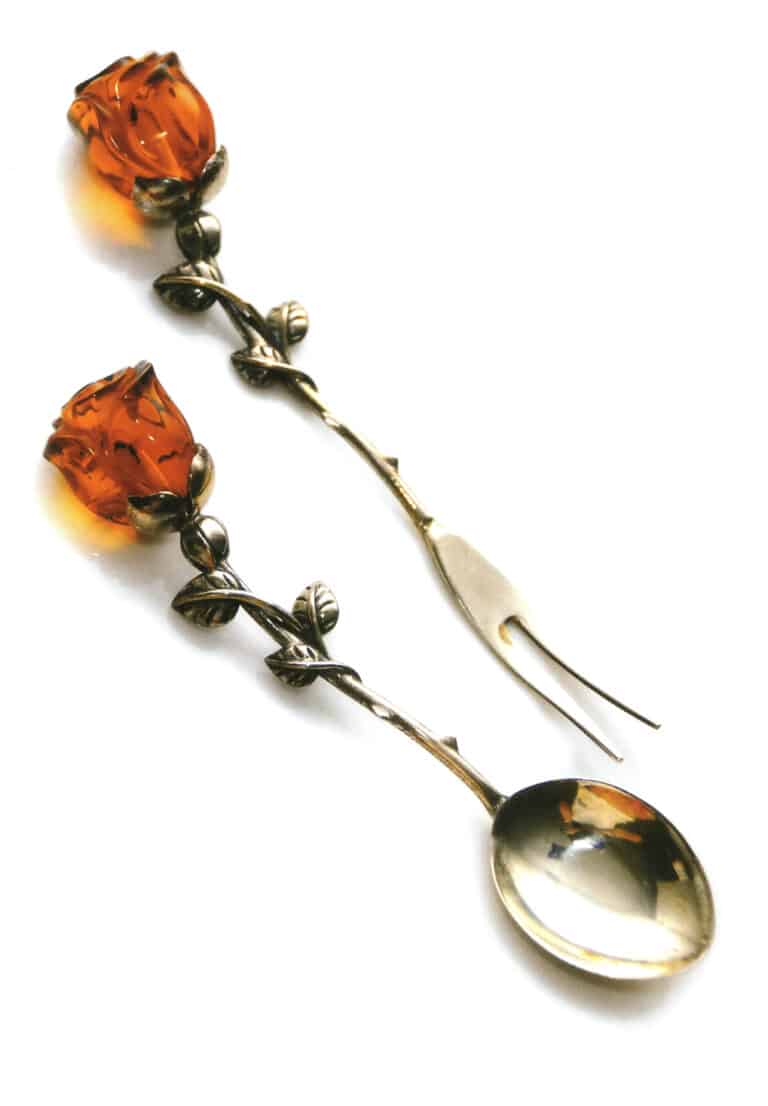
Hematurgical Rose Tableware

In commercial terms, transparent amber is called amber, while opaque amber is called beeswax; in fact, their composition is the same.
3. How do you choose and maintain?
When selecting beads, it is essential to ensure the size and color tone are consistent; when purchasing carved ornaments, it is advisable to choose those with fine craftsmanship and uniform texture.
Amber is a fossil resin sensitive to heat, abrasion, sunlight, and strong acids and bases (ammonia, fertilizers, detergents, perfumes, and hair sprays) and is prone to cracking. It should be kept away from heavy impacts or fire. If it gets dusty, wipe it clean with water. If you have olive oil, you can apply a thin layer on the surface to restore its luster. Yellow amber will gradually darken over time, turning into a reddish or brownish hue, which collectors highly seek after.
Section X Topaz
Topaz is known as aluminum fluorosilicate in geology, and yellow topaz is easily confused with citrine, so it is now commonly referred to as topaz in the market, with some calling it “yellow topaz,” with the transparent ones being the finest.
| Komposisi | Sistem kristal | Kekerasan | Gravitasi Spesifik | Indeks refraksi | Warna | Pembelahan | Patah tulang |
|---|---|---|---|---|---|---|---|
| Al2SiO4(F, OH)2 | Orthorhombic | 8 | 3.4 ~ 3.6 | 1.62 ~ 1.63 | Colorless, yellow, pink, wine yellow, green, and golden | Completely | Berbentuk cangkang |


champagne-coloured topaz
1. Market information is public.
Topaz comes in white, golden yellow, light orange-red, pink, blue, champagne, and other colors, with blue and champagne being the most common in the market. Since it is called yellow topaz, it is strange that it is not commonly seen in the market. This is mainly because yellow topaz (also known as Imperial Topaz, ranging from golden yellow to light orange-red) is primarily found in sizes of 1-3 carats, with 1 carat costing about US$31-37, making it significantly more expensive than blue or champagne topaz.
Blue topaz is classified by color into three types: London blue, royal blue, and Swiss blue. London Blue has a hint of black, Royal Blue is the darkest blue, and Swiss Blue is a lighter blue. Blue topaz is lighter and cheaper, with 1 carat costing US$3-4, and deeper colors costing 1 carat US$6-12. As for pink topaz, the color is mostly artificially treated, with 1 carat on the market costing US$6-9.
Because topaz has large crystal particles, sizes of 50-150 carats are also very common in the market. Due to high production, prices have not fluctuated much over the past decade, and sizes can be customized. If the topaz is cut in a millennium style, the price per carat is US$9-15.

royal blue topaz pendant
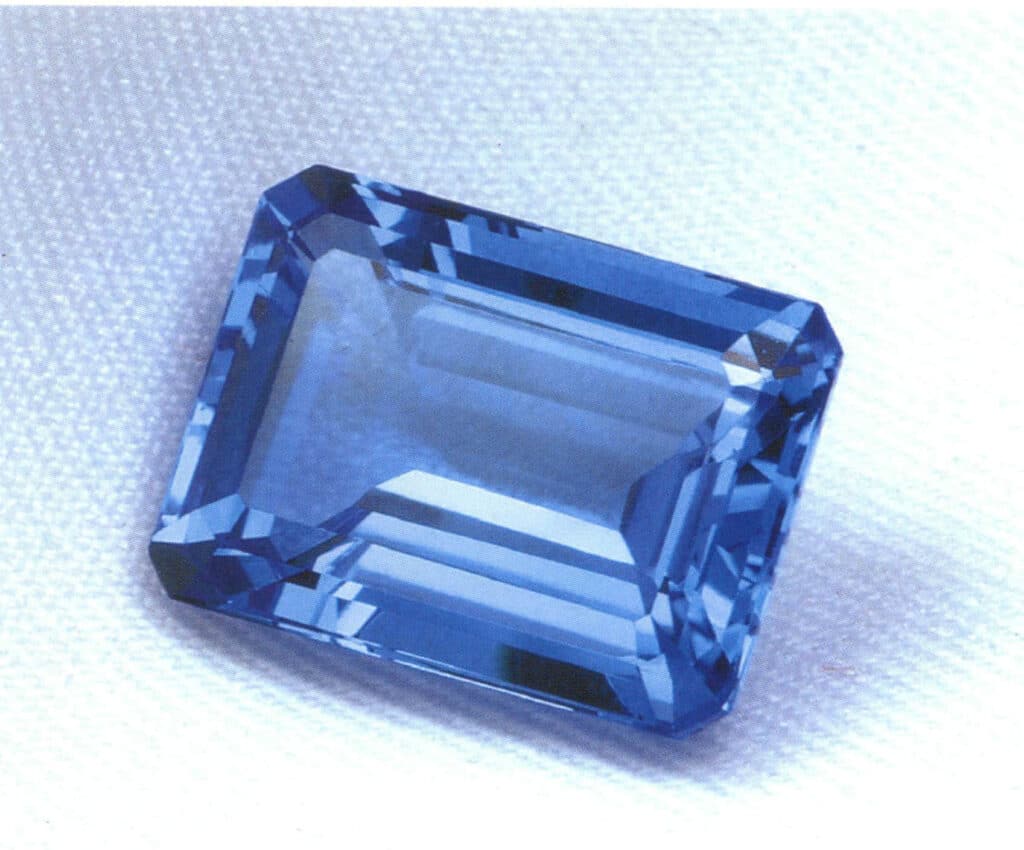
Swiss Blue Topaz gem Emerald cut
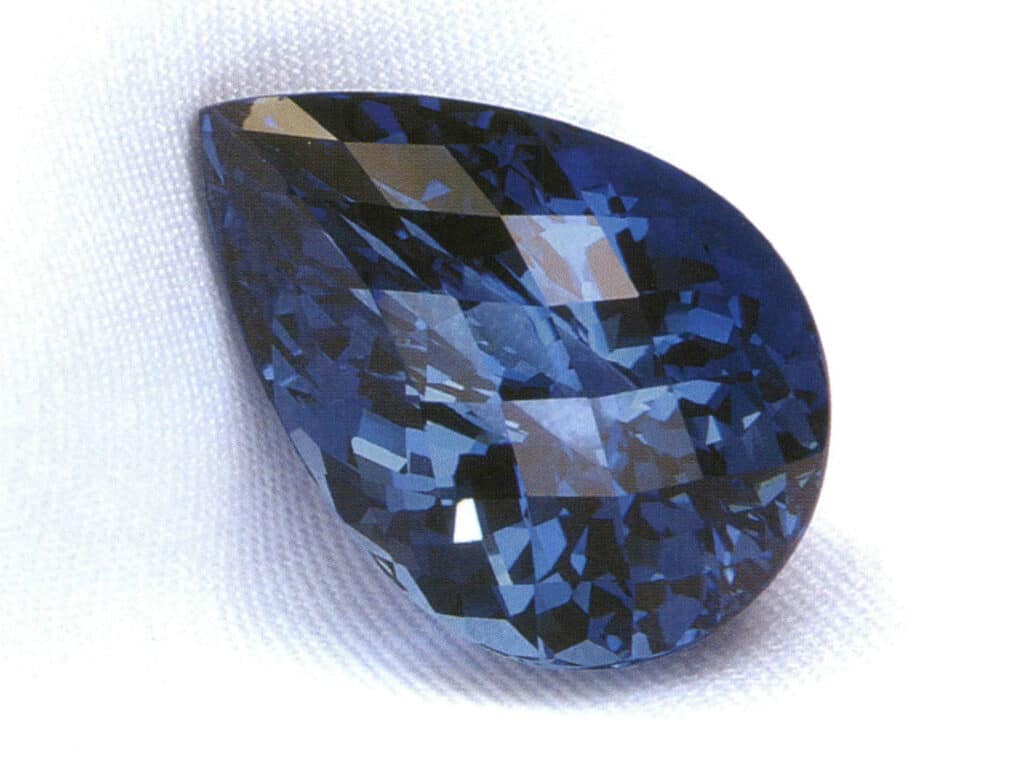
London Blue Topaz gem pear cut
2. How do you choose topaz?
Topaz is a timeless gemstone that always stays in style. Because it is affordable, it is also an entry point for consumers to engage with gemstones. Topaz is prone to chipping and breaking, so special care should be taken when collecting it to avoid scratches.
When purchasing, choose a color you like, but be particularly aware that blue topaz is usually produced from white topaz that has been irradiated. It is generally left for more than six months to allow radioactive materials to decay and become non-radioactive before being sold. This is an accepted practice in the global jewelry industry.
Section XI Zircon
Most people would think zircon is Cubic zirconia, but this is a misunderstanding. Zircon is natural zirconium silicate, while Cubic zirconia is made of artificial zirconia. The refractive index of hyacinth is high, especially for Blue Zircon, which has particularly good fire and can resemble beautiful diamonds, unlike Cubic zirconia, which cannot replicate it.
| Komposisi | Sistem kristal | Kekerasan | Gravitasi Spesifik | Indeks refraksi | Warna | Pembelahan | Patah tulang |
|---|---|---|---|---|---|---|---|
| ZrSiO4 | Tetragonal crystal system | 6 ~ 7.5 | 3.95 ~ 4.73 | 1.78 ~ 1.85 | Often appears in light green, yellow, brown, blue, and | - | Berbentuk cangkang |
Blue Zircons are mostly below 1-3 carats, with 1 carat costing US$15-21; zircon of 5-10 carats are relatively rare, with 1 carat costing between US$31-46; those over 10 carats are very scarce, costing US$93-156 per carat.
Blue Zircon is the best entry-level option for Sapphires, with a brilliant deep blue color akin to diamonds, making it an excellent material for jewelry designers to showcase their creativity. If you can’t afford blue diamonds, consider getting a 5-carat Blue Zircon to indulge!
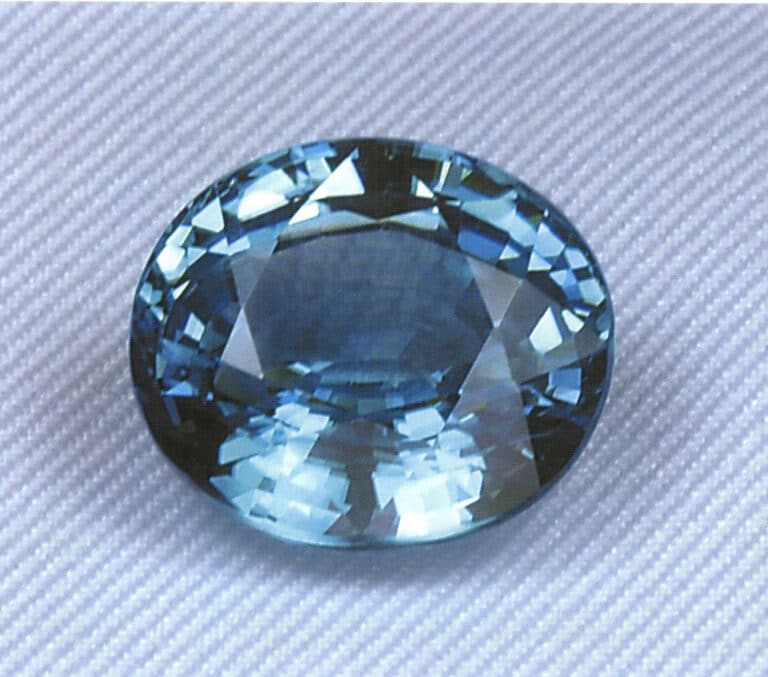
In addition to Blue Zircons, there are also yellow, brown, green, and red ones, mainly produced in Thailand, Sri Lanka, Laos, Myanmar, and other places. The dazzling colors are worth savoring.
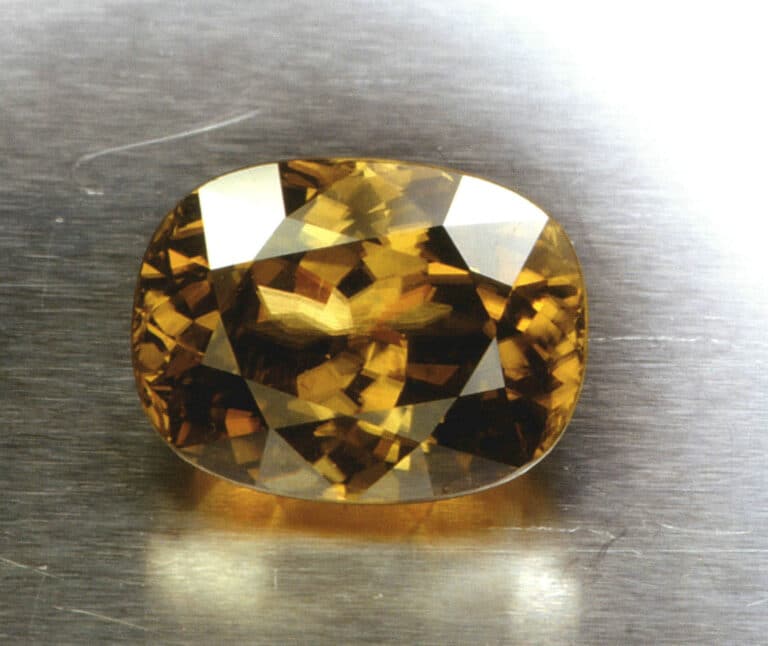
Yellow Zircon gems oval cut

Yellow Zircon gems oval cut finger ring
Section XII Spodumene
Spodumene, also known as Kunzite, is named after Dr. George Frederick Kunz (1856-1932), who discovered it in 1902. Dr. Kunz was a crucial contemporary gemologist in the United States, showing his passion for gemology at a young age. The globally accepted unit of gem weight, “carat,” was advocated and established as an international standard by Dr. Kunz in the early 20th century. The primary sources of spodumene are in the United States, Brazil, and Pakistan.
| Komposisi | Sistem kristal | Kekerasan | Gravitasi Spesifik | Indeks refraksi | Warna | Pembelahan | Patah tulang |
|---|---|---|---|---|---|---|---|
| LiAISi2O6 | monoclinic crystal system | 6 ~ 7 | 3.18 | 1.660 ~ 1.676 | Often pinkish purple to dark purple, yellow, green | Fully stigmatic | jagged to lobed |
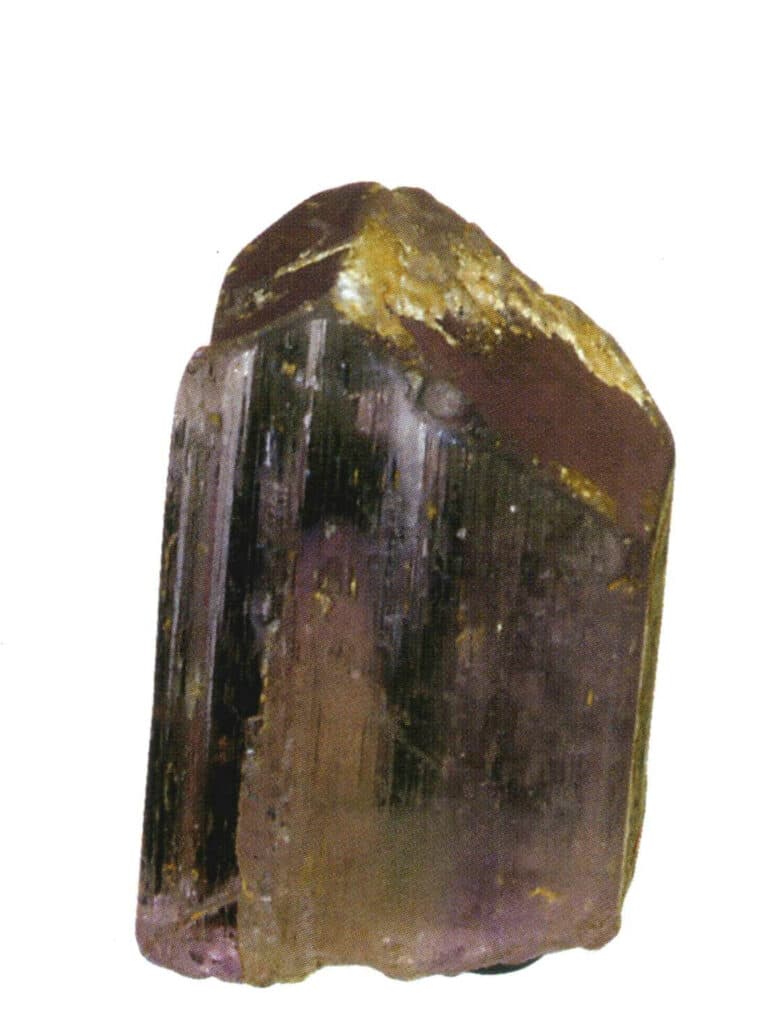
Initially, spodumene was mainly used to extract lithium (Li) elements, but later, it was cut and polished into gemstones due to its captivating colors. In addition to the violet-colored Kunzite, there is also yellow spodumene, which resembles light yellow crystals and is not commonly found in the market; the green spodumene is called hiddenite, which can rival jadeite or emerald, with its deep green hue making it hard to look away!
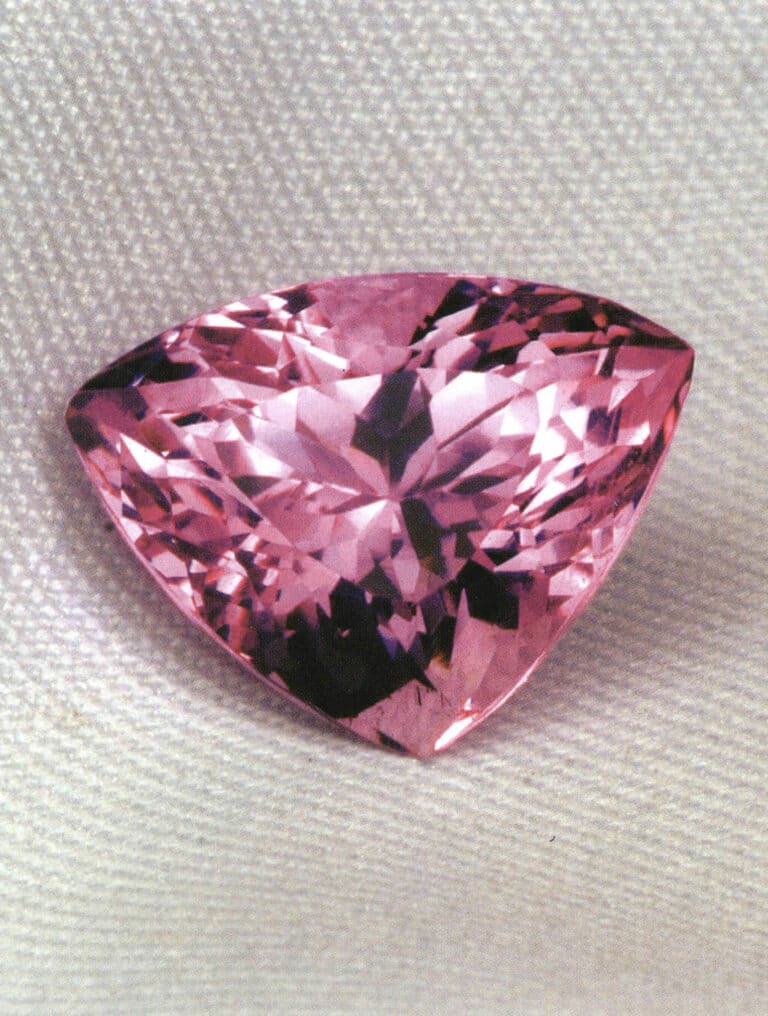
Purple spodumene
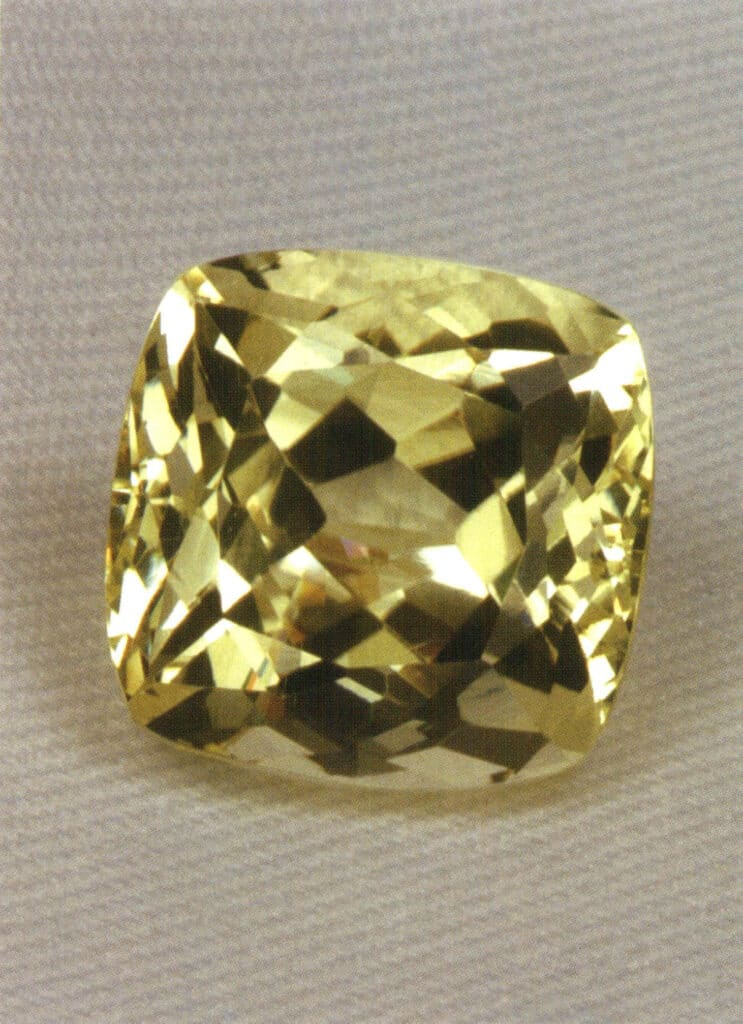
Yellow spodumene
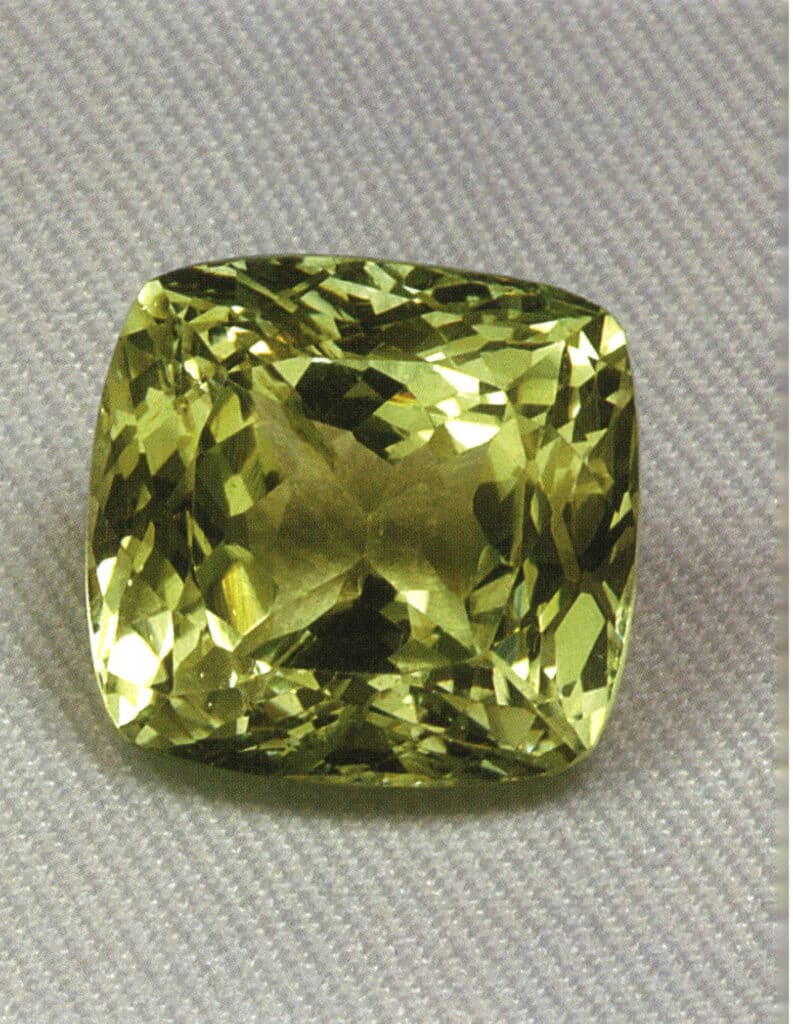
Green spodumene
Selection and Maintenance
Kunzite has become very popular in recent years, mainly driven by the international brand Tiffany, making many people pay attention to this violet-colored Kunzite. Kunzite comes in light pink, pink, and violet colors, with prices depending on the depth of color. The average cost for light pink Kunzite is US$ 6-12 per carat; pink Kunzite is US$15-31; violet is the highest grade, with an average price of US$37-62 per carat. In addition to selecting the color, one should also consider the quantity of inclusions and the brilliance of the cut.
Kunzite under 10 carats is standard, while the best-selling size is around 10-30 carats. Larger Kunzite can reach up to 30-100 carats, and those over 100 carats are pretty rare in the market, with many jewelry stores using them as store treasures.
Due to the unstable colors of the spodumene family, Kunzite is a rare natural gemstone that can fade when exposed to sunlight, earning it the title of “evening gemstone,” making it most suitable for wearing at evening events. When storing, remember not to expose it to intense light; it is best kept in a jewelry box. When set as a loose stone, it is also essential to remind the setter not to apply direct heat or electroplating. Once the color lightens or even turns white, it cannot be restored, and its value will immediately disappear. Additionally, Kunzite has perfect cleavage, so it should be kept from impacts to avoid scratches or damage.
Section XIII Prehnite
At first hearing, the name “Prehnite” might suggest a purple gemstone, but its main colors range from yellow-green to emerald green. It is named after Colonel Pliny because its crystal shape resembles grapes. Five or six years ago, glamor swept across China, and many designers adopted Prehnites to create various accessories. In those years, more than half of the world’s production of Prehnites was sold to China.
| Komposisi | Sistem kristal | Kekerasan | Gravitasi Spesifik | Indeks refraksi | Warna | Pembelahan | Patah tulang |
|---|---|---|---|---|---|---|---|
| Ca2Al(AlSi3O10) (OH)2 | Rhombohedral | 6 ~ 6.5 | 2.8 ~ 2.95 | 1.61 ~ 1.63 | Colourless to grey turning yellow, yellow-green or white | Inconspicuous | Uneven |
The price of Prehnite mainly depends on its color and clarity. The higher the price, the greener, more transparent, and flawless. Cheap Prehnite of 1 carat costs US$0.9-1.5, most of which have internal stone patterns. Light yellow or pale green clean Prehnite costs US$1.5-6 for 1 carat; medium-grade color Prehnite is priced at US$12-18 for 1 carat. As for flawless Prehnite, which is as green as glass-like jade, due to the local raw materials in Thailand being out of stock, polished rough stones have not been seen for over a year. What is available in the market is mainly from a few years ago, with the price being US$46-62 for 1 carat.
The characteristic of Prehnite is its oily feel, with large crystalline particles that can reach 40-50 carats, mostly cut into cabochons, with a small portion carved into pendants. It has a hardness of 6 and is prone to wear, so avoid collisions. Light yellow-green color is the most common in the market.
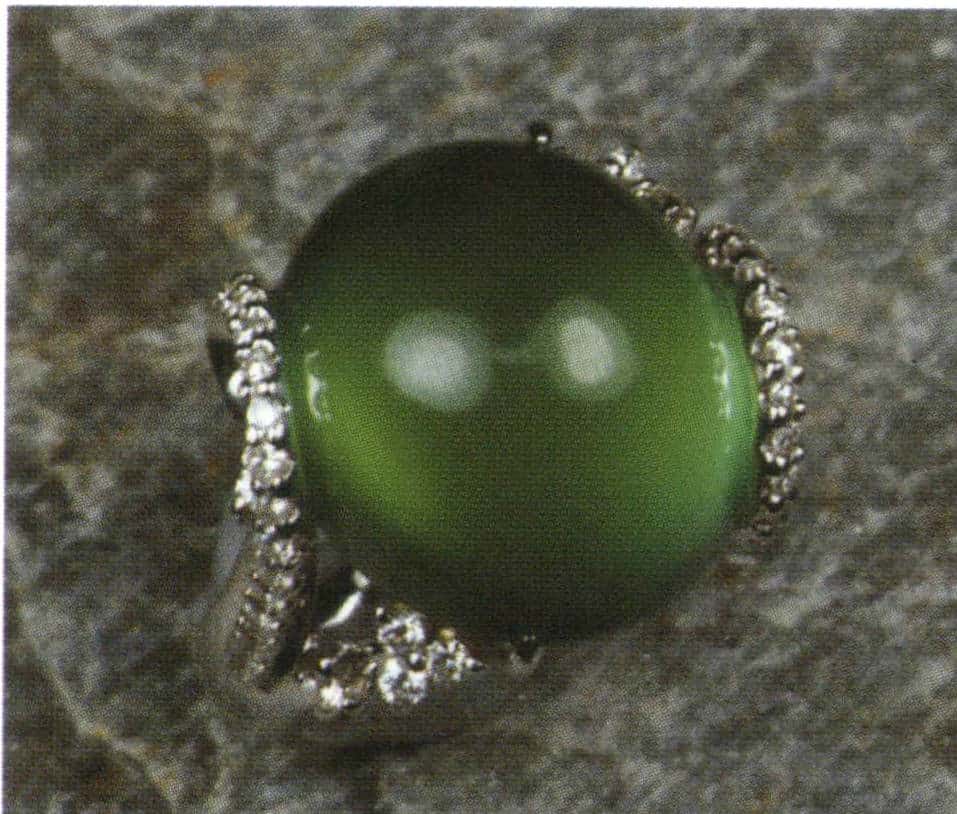
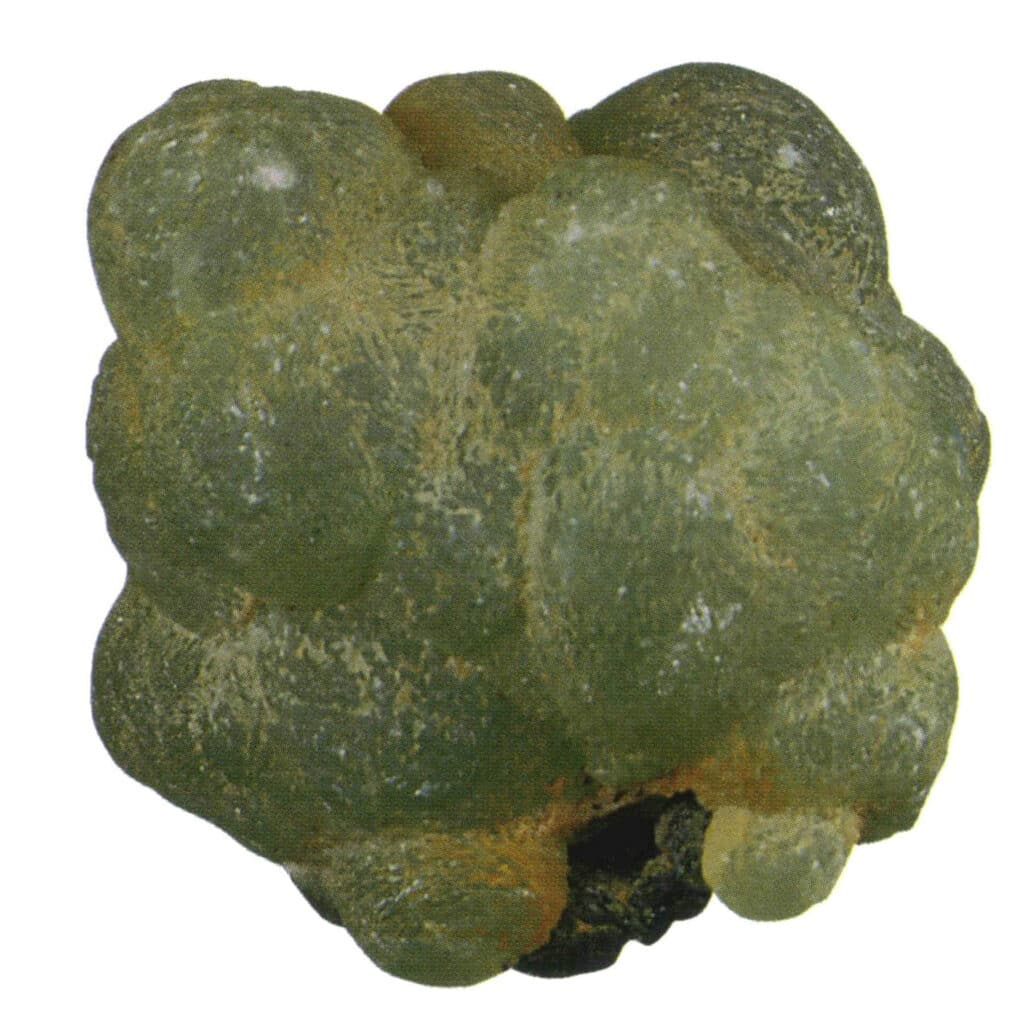
Prehnite mines look like clusters of grapes.

Prehnite Pendant
Section XIV Sphene
The name of the Sphene comes from the Greek word “wedge,” its crystals are relatively flat and wedge-shaped. It has an intense fire and rich colors, with a brilliance that exceeds that of diamonds. The colors are mostly yellow, brown, and green, with solid pleochroism and strong double refraction, so the overlapping phenomenon of the back facets can be seen from above.
| Komposisi | Sistem kristal | Kekerasan | Gravitasi Spesifik | Indeks refraksi | Warna | Pembelahan | Patah tulang |
|---|---|---|---|---|---|---|---|
| CaTi (SiO5) | Monoclinic system | 5 ~ 5.5 | 3.52 | 1.90 ~ 2.034 | Green, yellow-green, brownish-yellow. Brown | Columnar cleavage | Shell-like to irregularly fractured |
Sphene has suddenly risen in popularity in the last three years. In the Japanese market, Sphene over 10 carats cost more than US$ 312 per carat, and it is difficult to find large stones. The most expensive is green Sphene, followed by yellow-green, then yellow-brown. Typically, the maximum size is 1-3 carats, and they often contain inclusions, with clean ones being rare. For Sphene under 3 carats, the price is US$ 15-31 per carat; for those around 10 carats, it is US$ 31-78; green Sphene over 10 carats is the rarest, usually costing US$156-218 per carat.
When selecting Sphene, pay attention to the cut, fire, and shape; the more robust the fire, the better. Since Sphene has a hardness of only 5.5, avoid collisions and friction.

Section XV Peridot
Peridot is one of the earliest minerals formed during magma crystallization and is associated with volcanic basalt. It can be found in places like Penghu Bay and Green Island in China Taiwan. Peridot has a lot of inclusions, making it difficult to find specimens with high clarity. The colors include yellow-green, green, and dark green, with the Burmese emerald green Peridot being the most popular and expensive. Burmese Peridot in the size of 5 to 10 carats costs between US$ 37-62 per carat; for those over 10 carats, it costs between US$ 78-109. The characteristic of Peridot is that it has a slight haziness, unlike other green gemstones that are more transparent.
| Komposisi | Sistem kristal | Kekerasan | Gravitasi Spesifik | Indeks refraksi | Warna | Pembelahan | Patah tulang |
|---|---|---|---|---|---|---|---|
| (Mg, Fe)2SiO4 | Orthorhombic | 6.5 ~ 7 | 3.27 ~ 3.48 | 1.654 ~ 1.690 | Yellow-green, often appearing from light green to deep green. | Not completely clear. | Berbentuk cangkang |
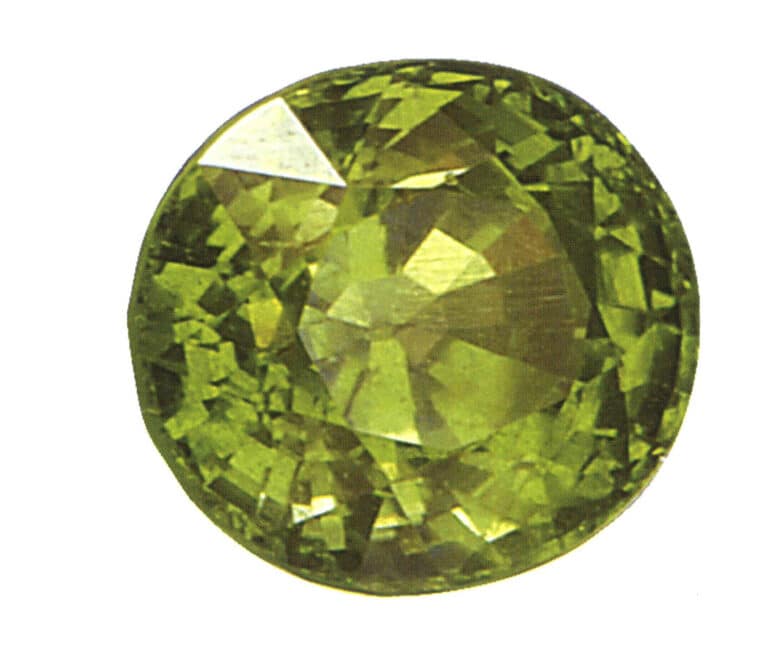
it was pretty challenging to find Peridot over 10 carats, as the main ones visible on the island then were from Jilin. However, in recent years, it has been found that there are also many Burmese Peridots over 10 carats, although many have stone lines or black inclusions; in Thailand & Pakistan, some Peridots close to 30 carats with dark green, and the price is relatively low.
Since 2008, a lot of Peridot has been released from China and Pakistan; thus, the price has also dropped significantly. A 1-carat Pakistani Peridot can be bought for US$3-6; a 1-5-carat Peridot costs US$9-15; for sizes between 5 to 10 carats, it costs US$31-46; for 10-20 carats, it costs US$62-78; for over 20 carats, it costs US$109-125. A 1-carat Peridot is cheap so that it can be custom-cut into various shapes and sold in bulk to silver jewelry factories, or set into pendants or rings for sale. In the Taipei Jade Market, small Peridot chips can be bought for ten Dollars per small pack, which can be strung into necklaces or bracelets. Peridot is relatively soft, not resistant to impact, and should not be stored together in a pile.
